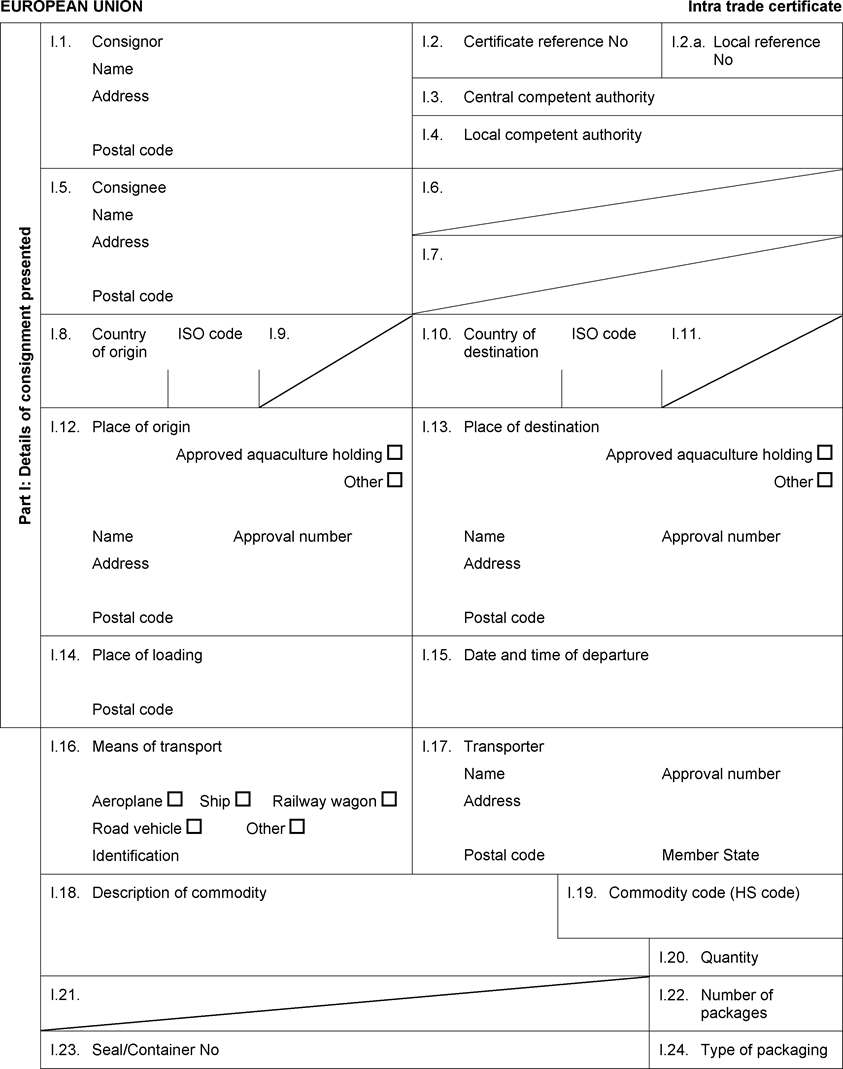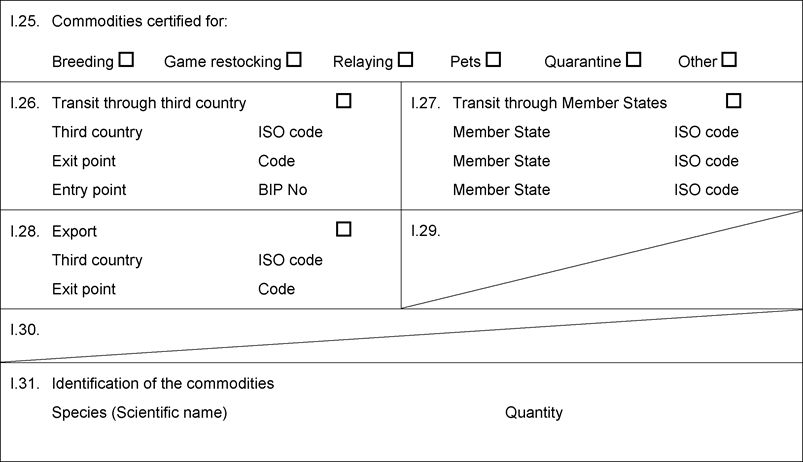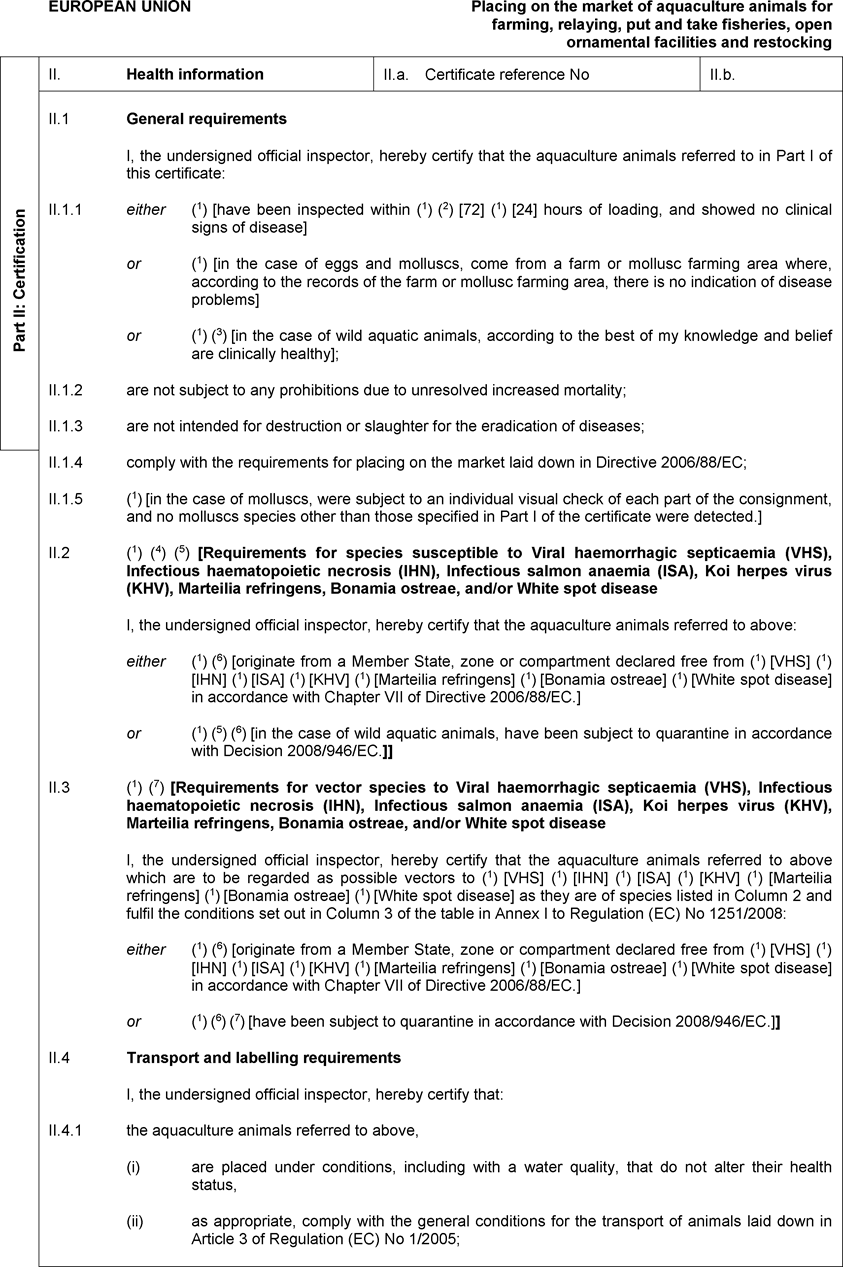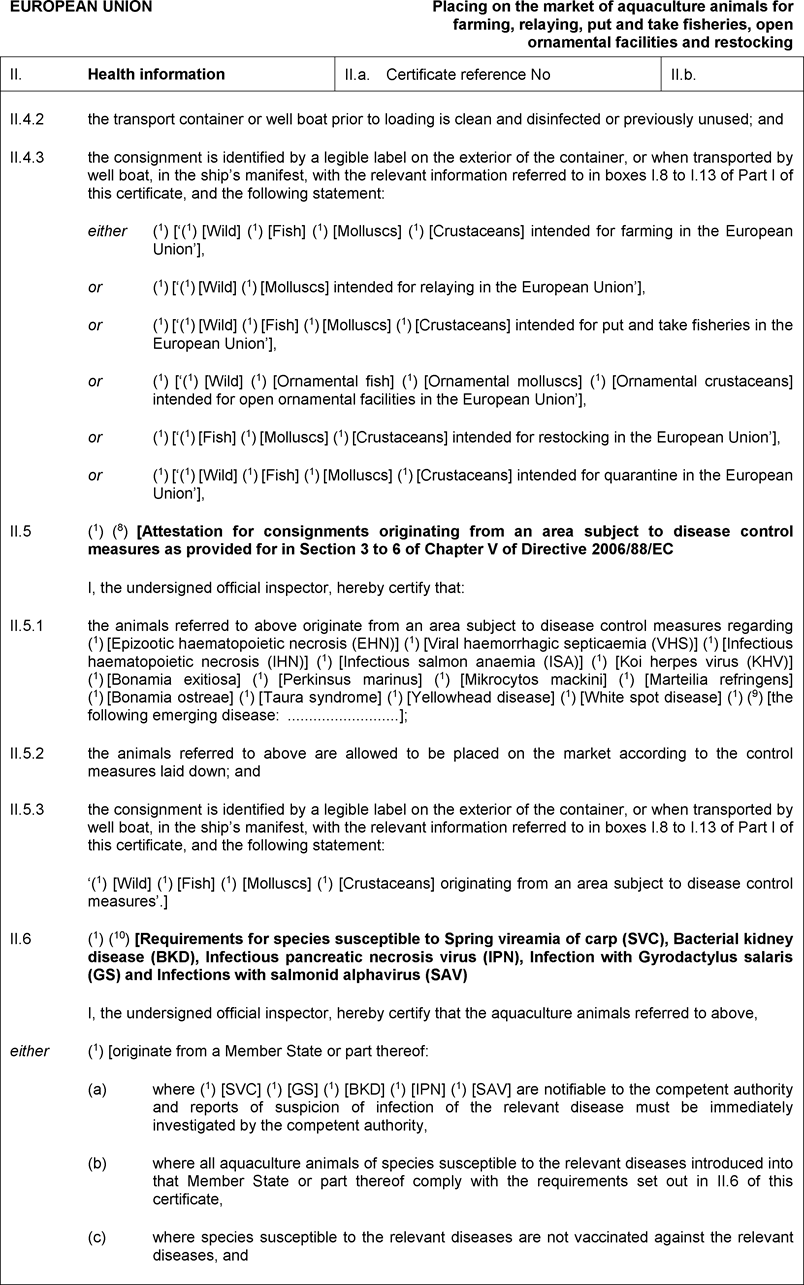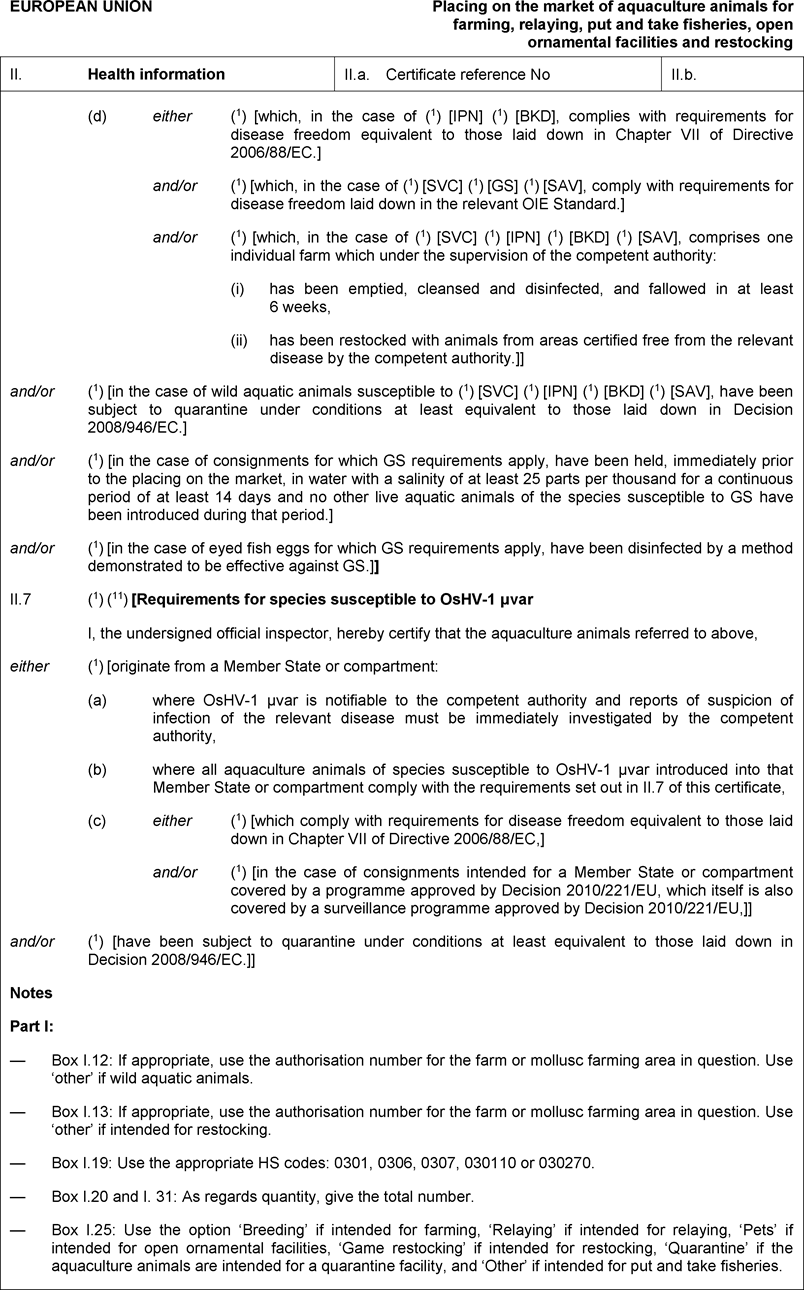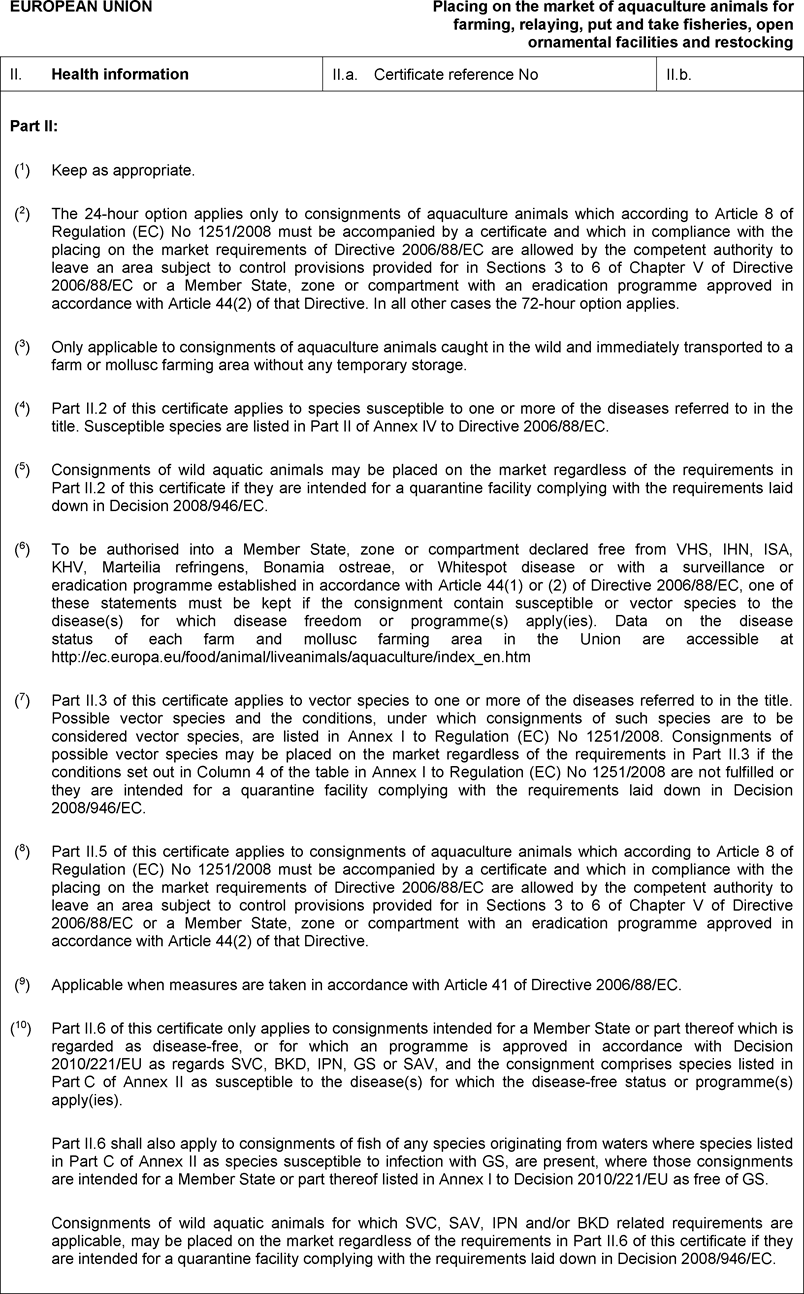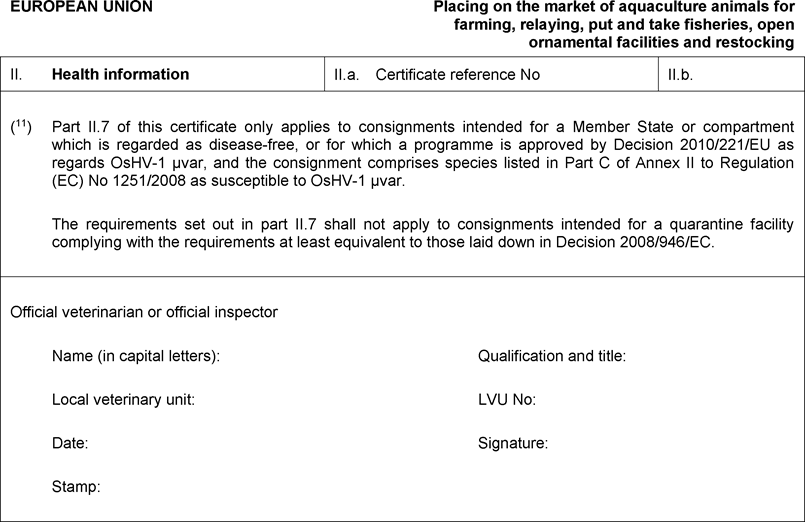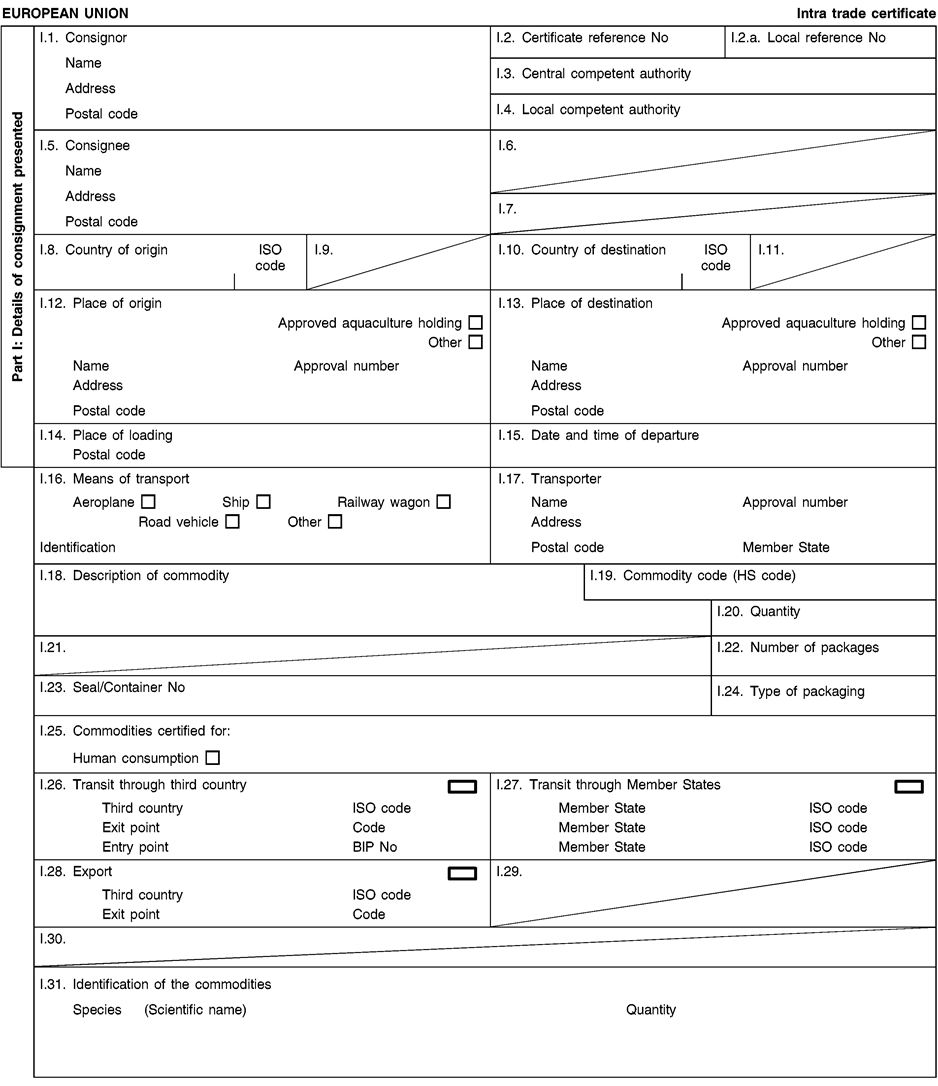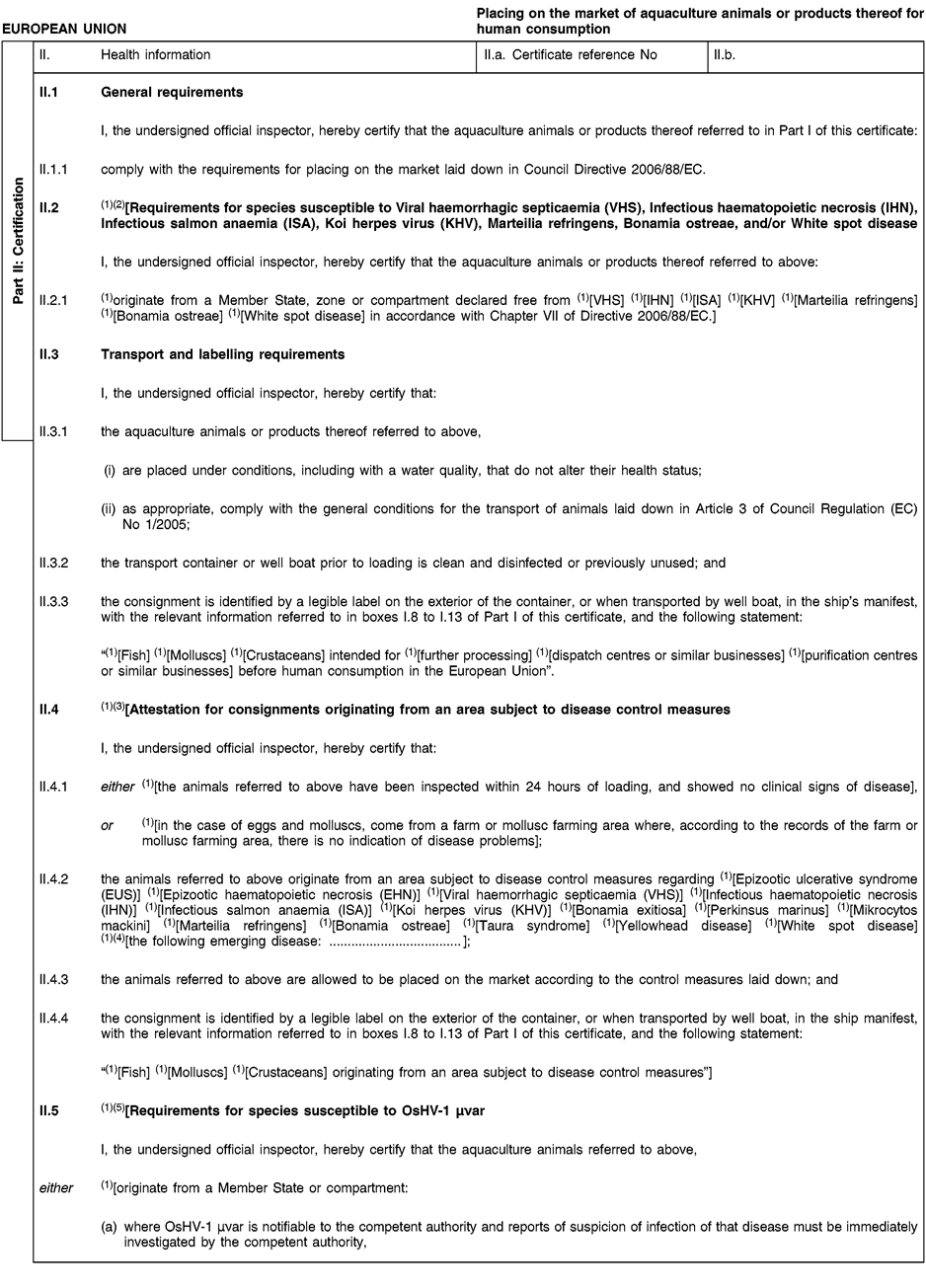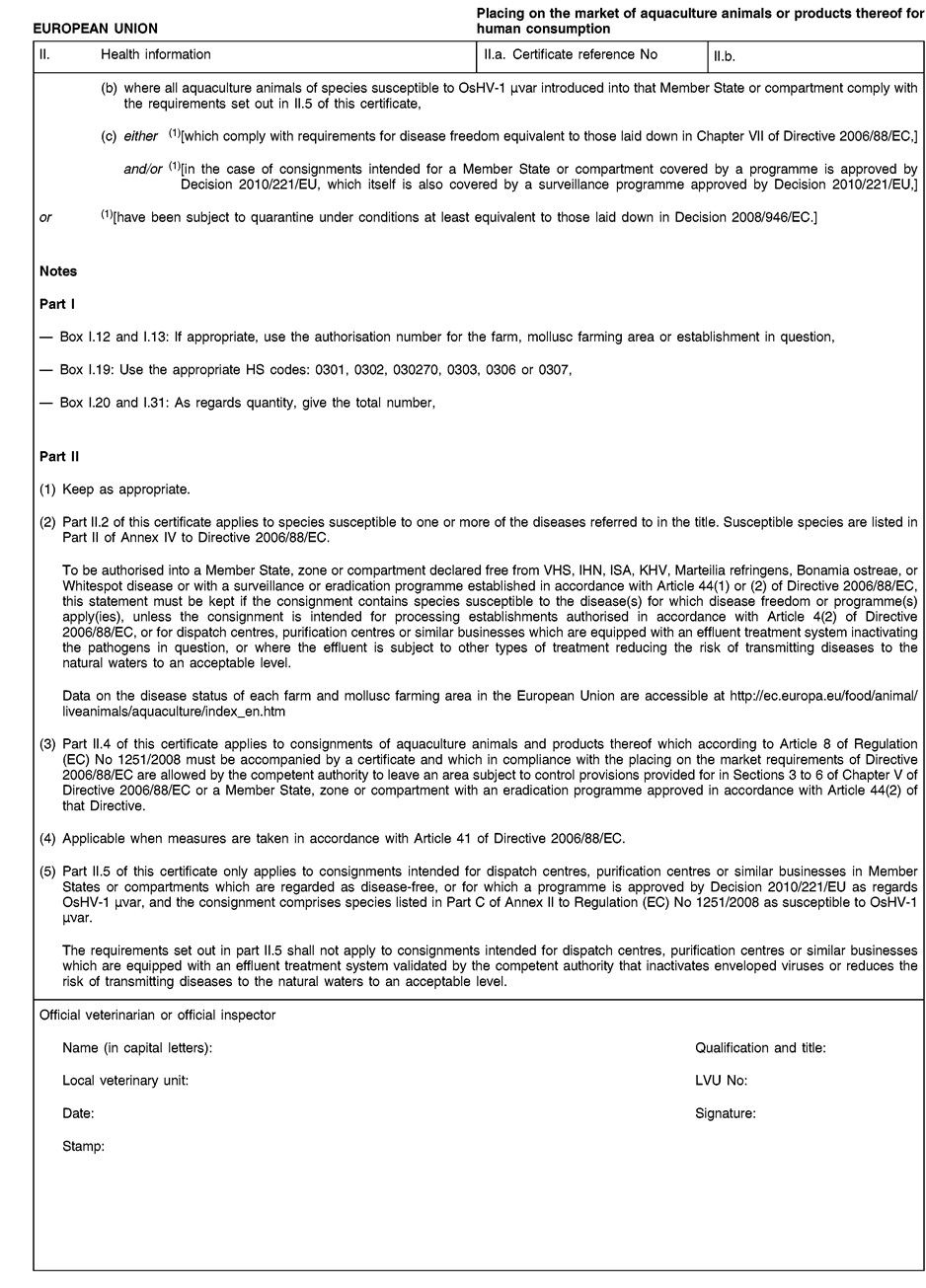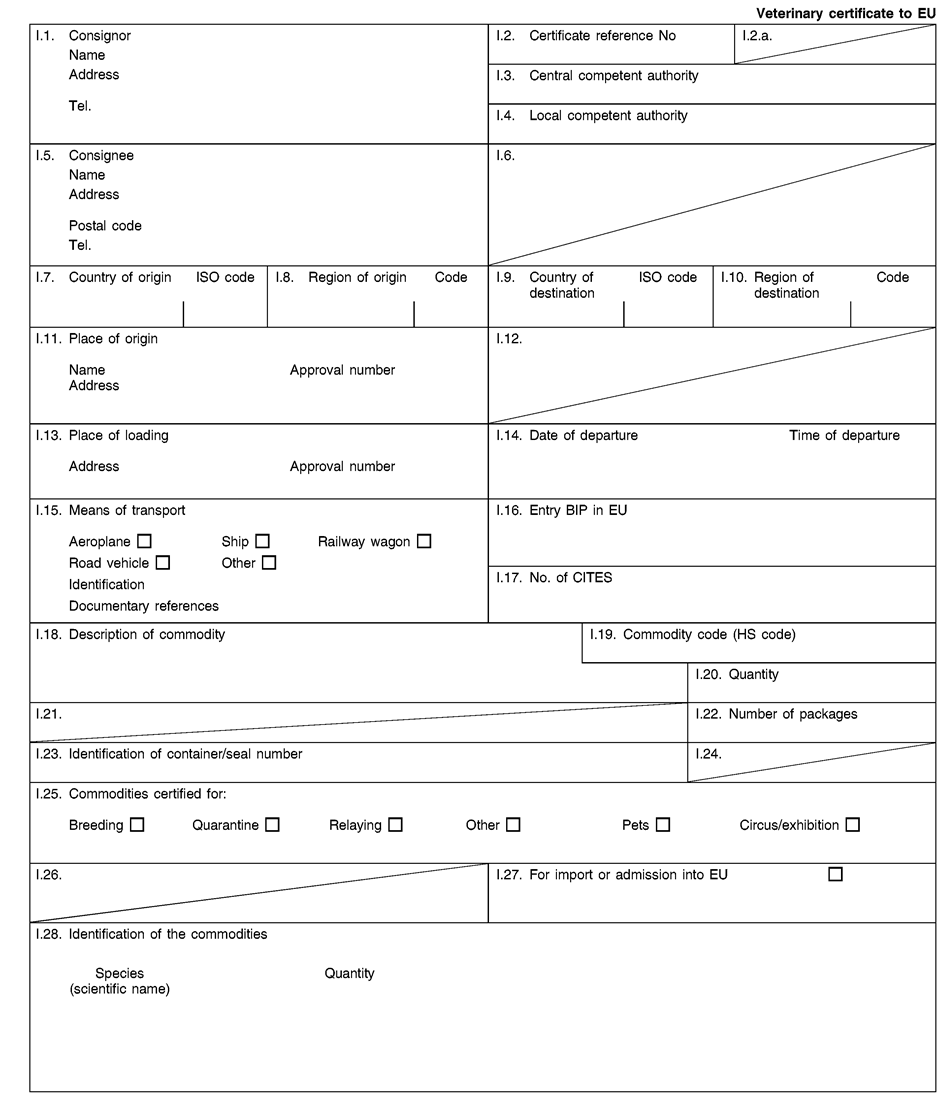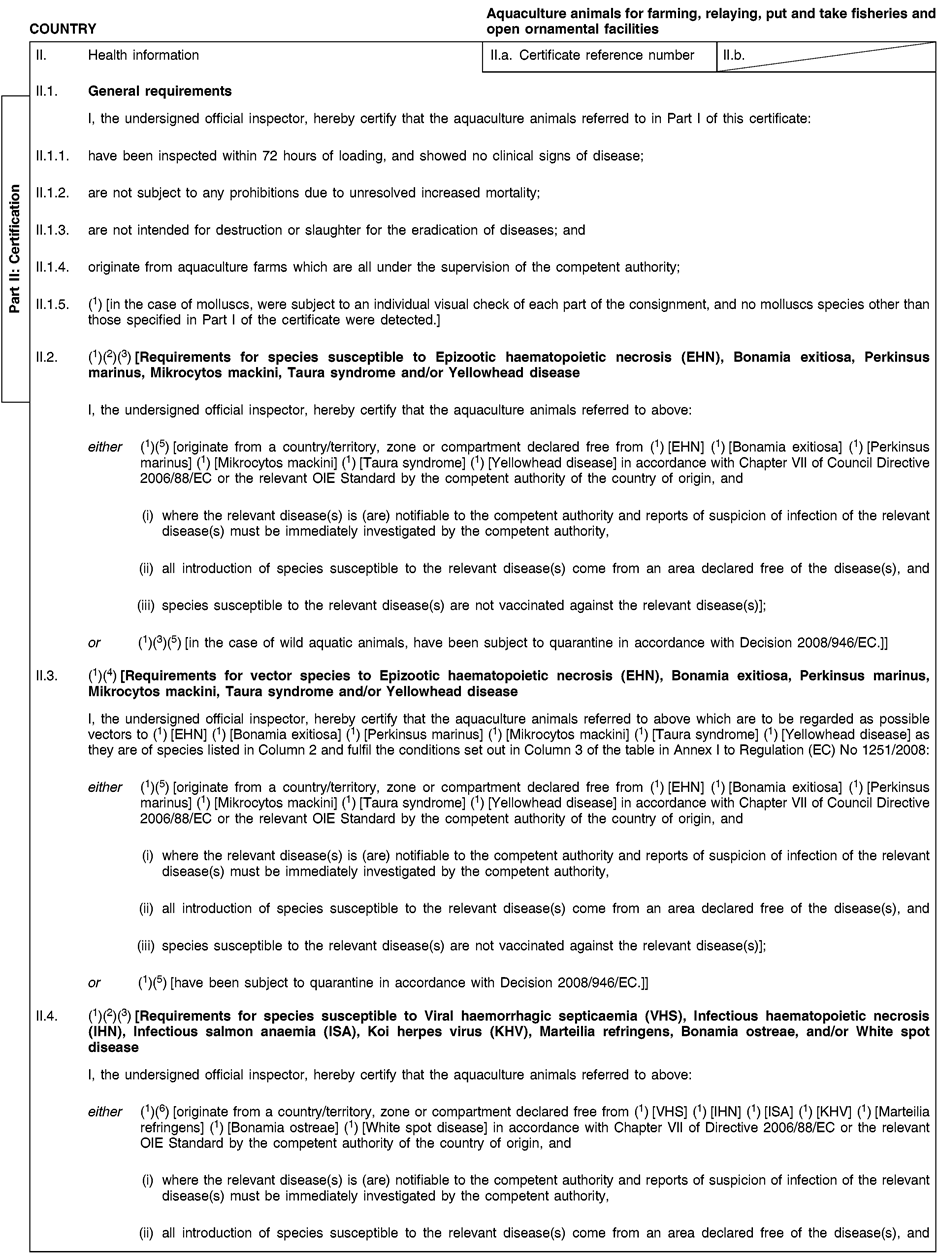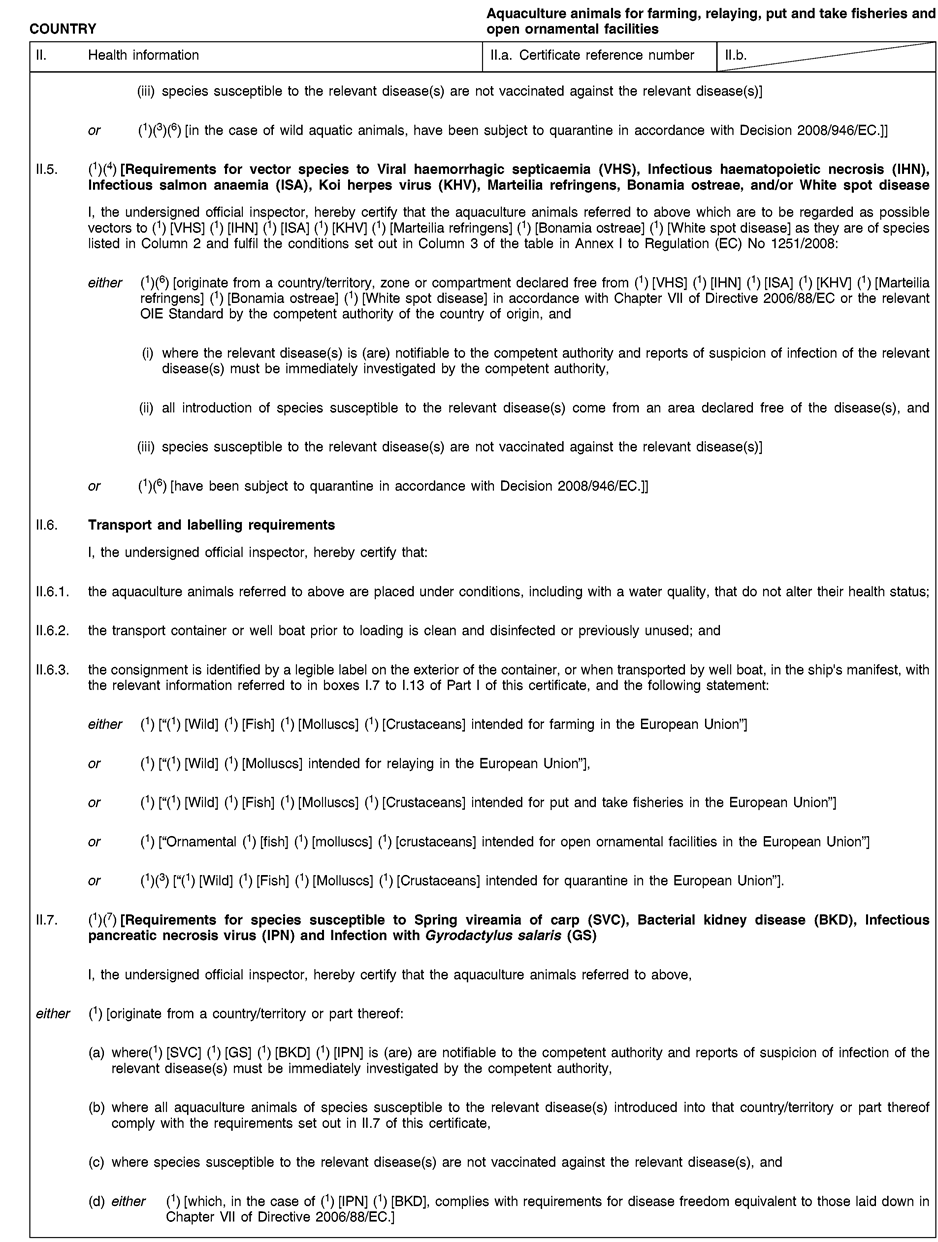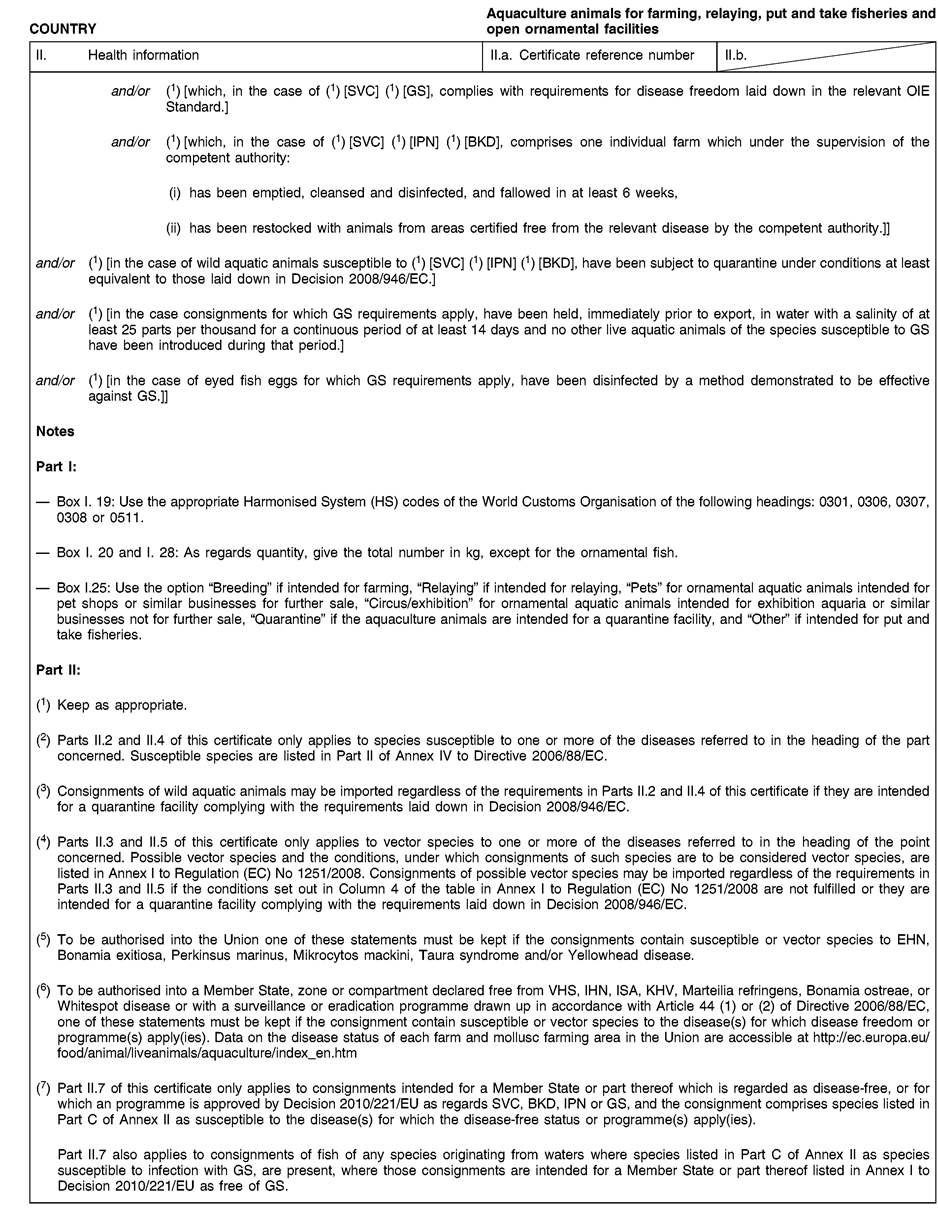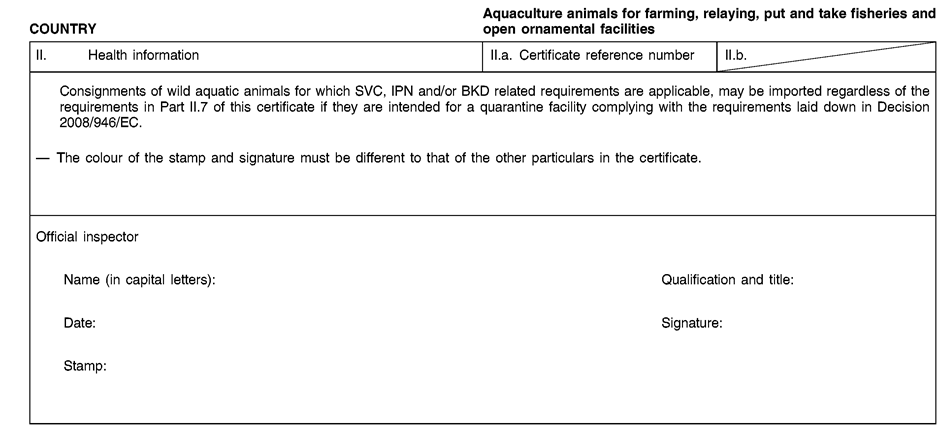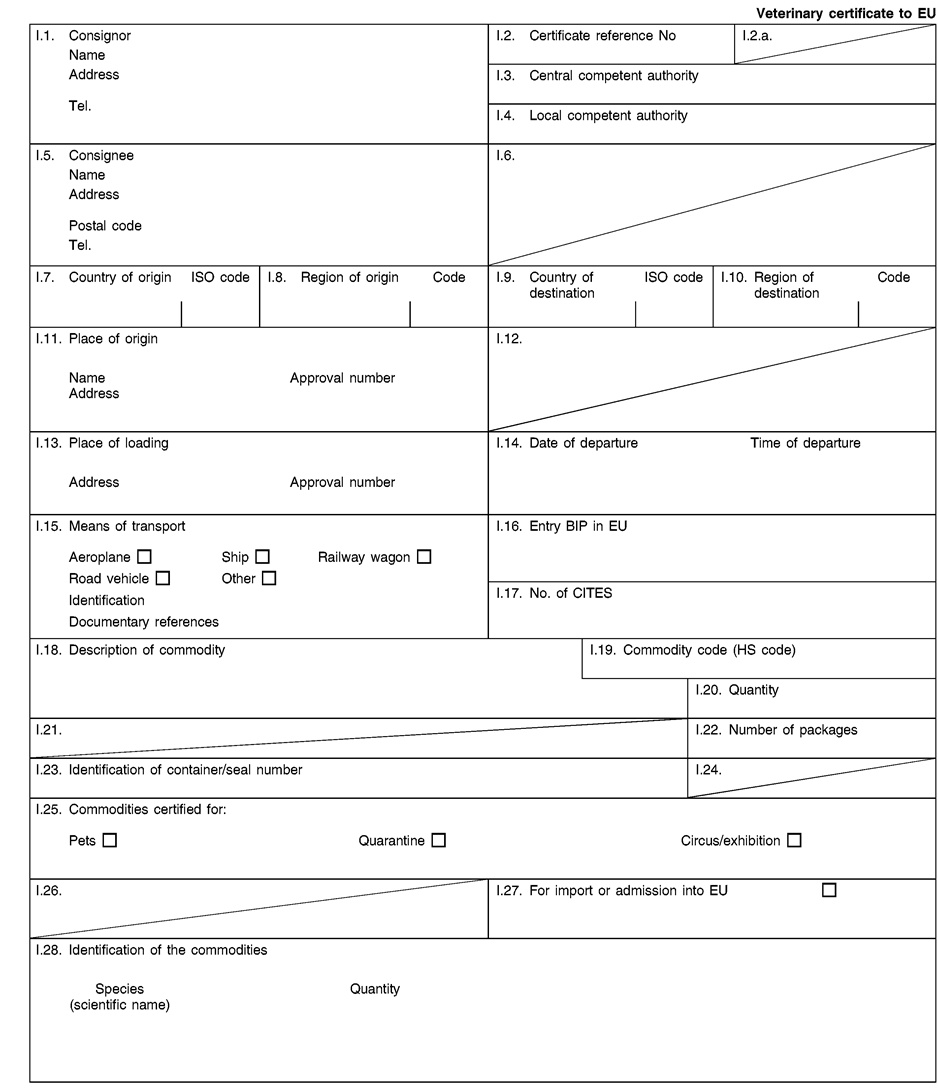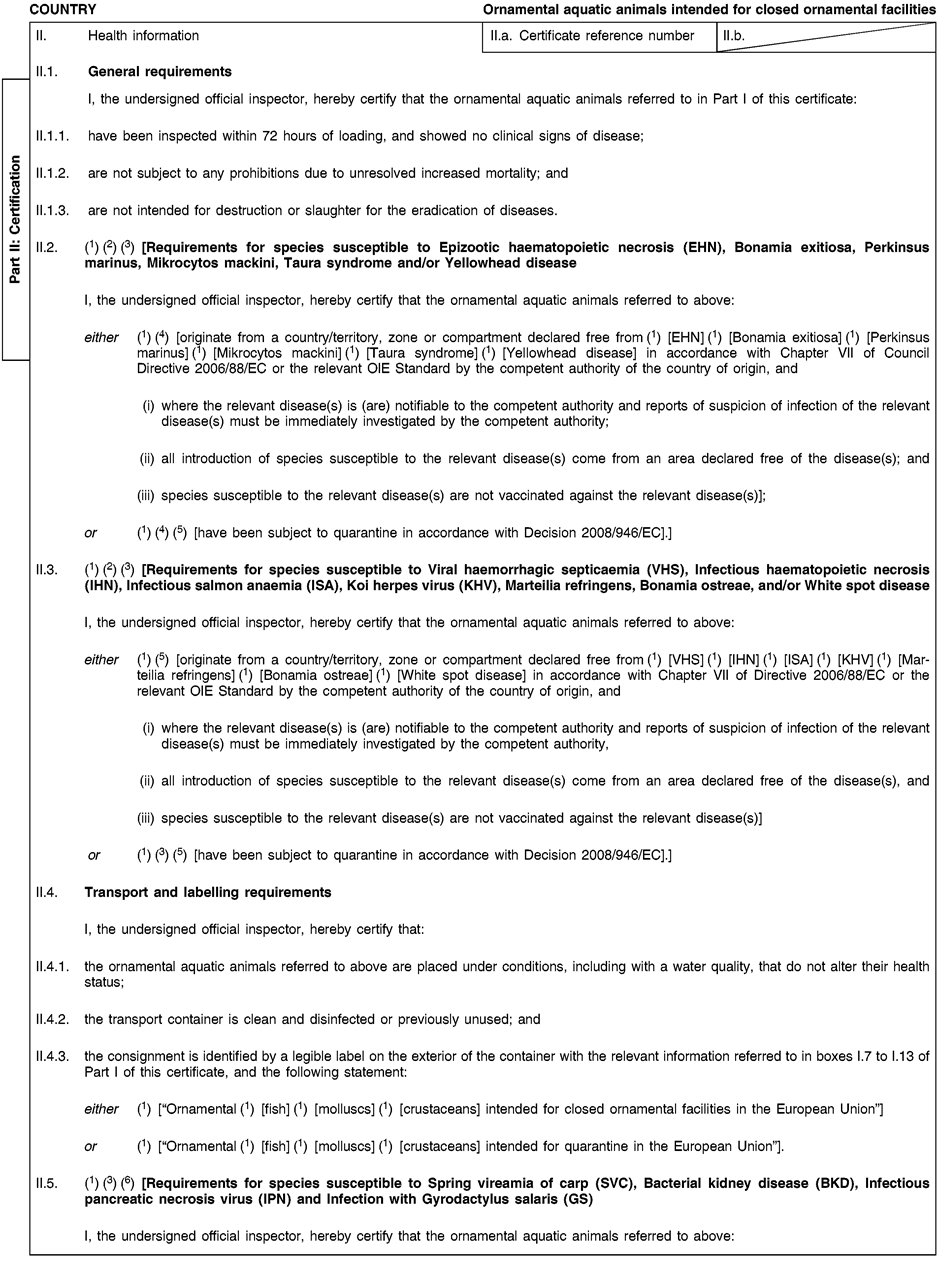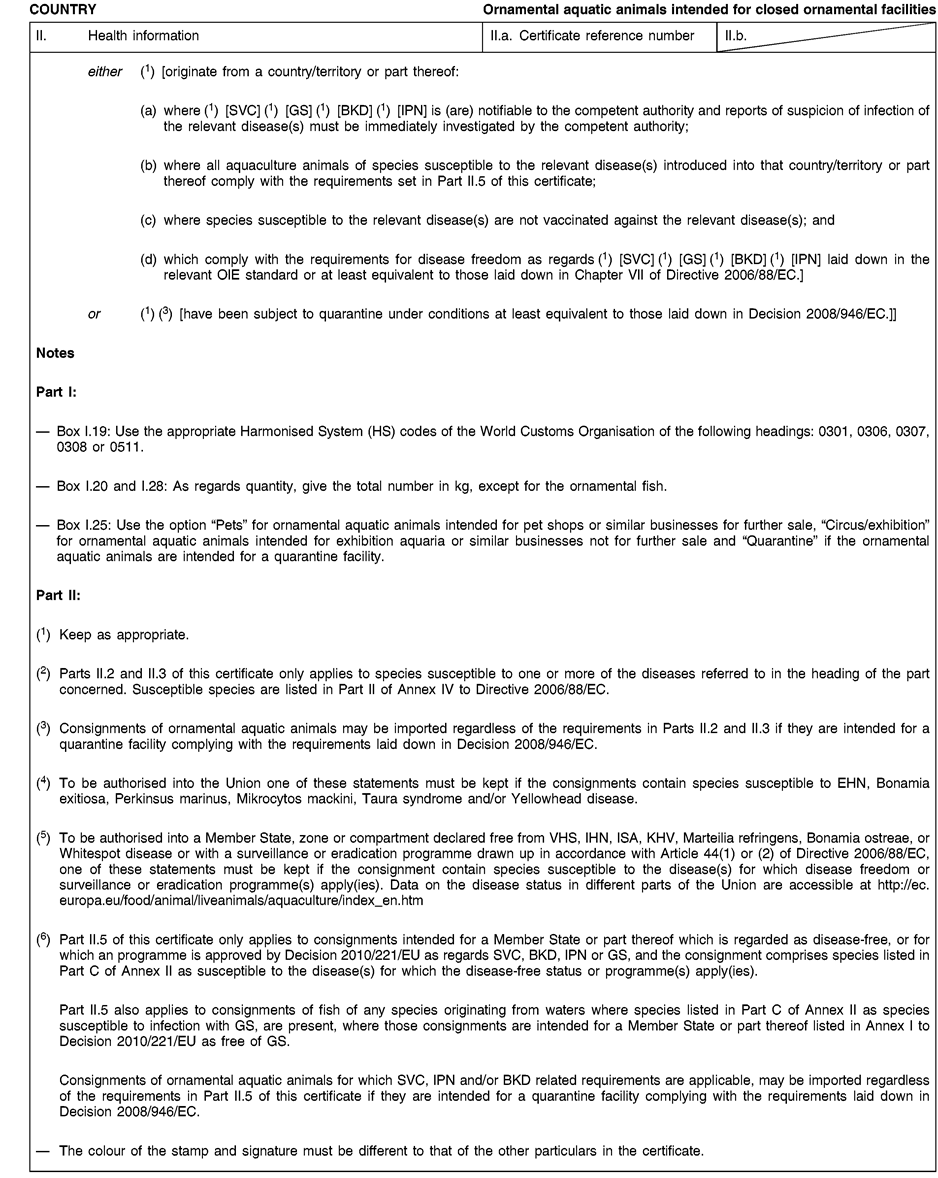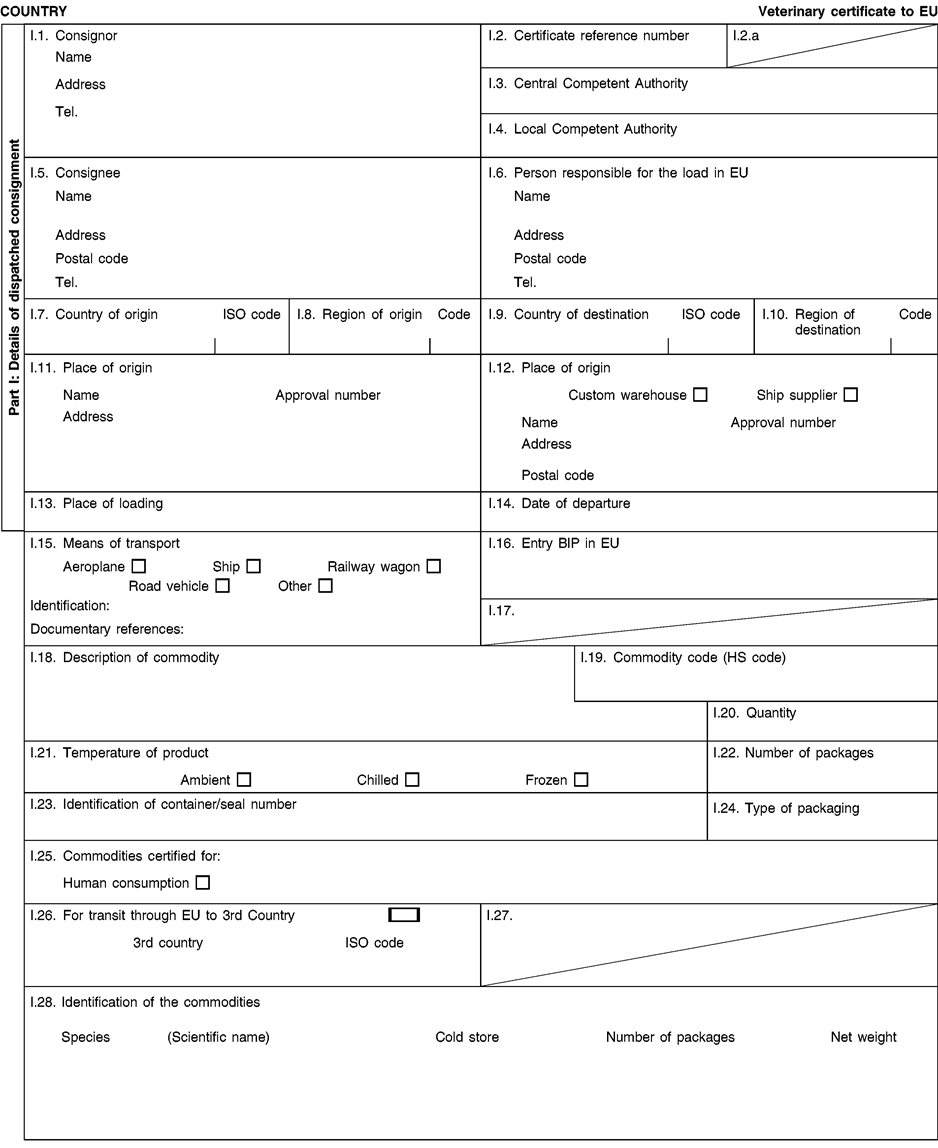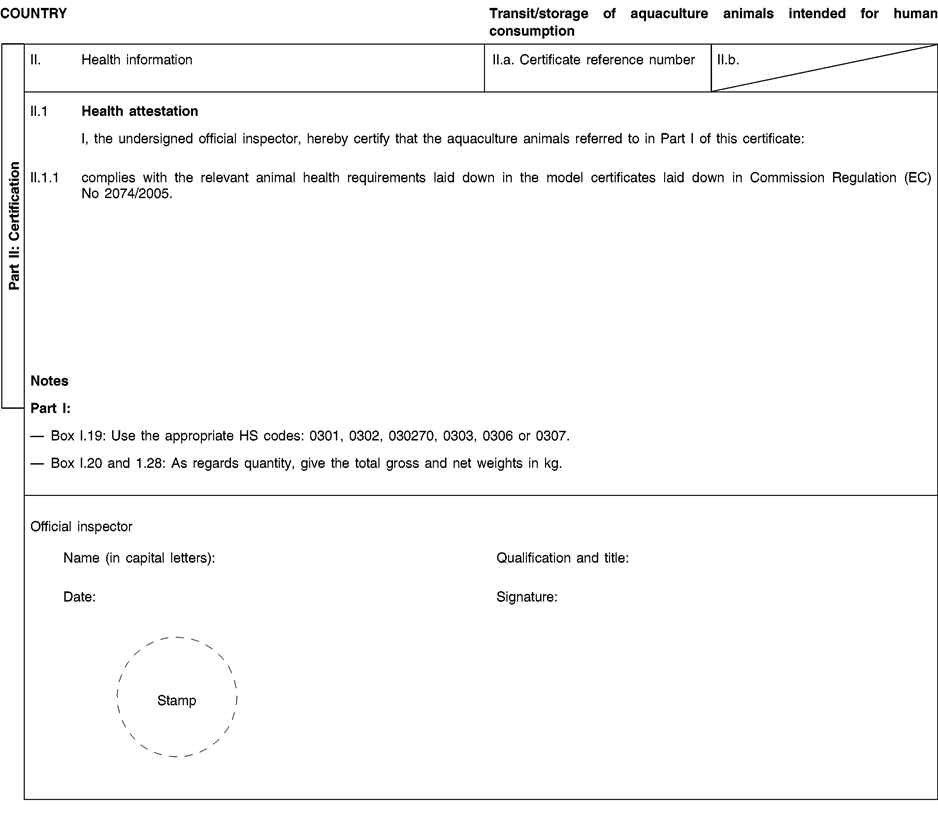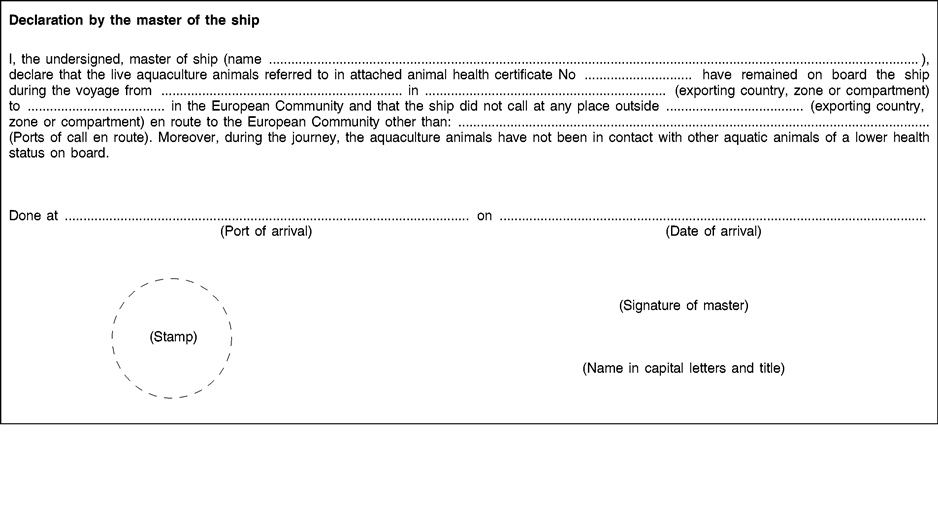- Latest available (Revised)
- Point in Time (31/01/2020)
- Original (As adopted by EU)
Commission Regulation (EC) No 1251/2008Show full title
Commission Regulation (EC) No 1251/2008 of 12 December 2008 implementing Council Directive 2006/88/EC as regards conditions and certification requirements for the placing on the market and the import into the Community of aquaculture animals and products thereof and laying down a list of vector species (Text with EEA relevance)
You are here:
- Regulations originating from the EU
- 2008 No. 1251
- Whole Regulation
- Previous
- Next
- Show Geographical Extent(e.g. England, Wales, Scotland and Northern Ireland)
- Show Timeline of Changes
More Resources
Revised version PDFs
- Revised 14/12/20191.51 MB
- Revised 01/10/20161.41 MB
- Revised 03/02/20141.34 MB
- Revised 01/07/20131.34 MB
- Revised 26/11/20121.34 MB
- Revised 01/05/20111.80 MB
- Revised 01/01/20111.66 MB
- Revised 15/05/20100.71 MB
- Revised 01/10/20091.04 MB
This is a legislation item that originated from the EU
After exit day there will be three versions of this legislation to consult for different purposes. The legislation.gov.uk version is the version that applies in the UK. The EU Version currently on EUR-lex is the version that currently applies in the EU i.e you may need this if you operate a business in the EU.
The web archive version is the official version of this legislation item as it stood on exit day before being published to legislation.gov.uk and any subsequent UK changes and effects applied. The web archive also captured associated case law and other language formats from EUR-Lex.
Changes over time for: Commission Regulation (EC) No 1251/2008
Version Superseded: 31/12/2020
Alternative versions:
- 12/12/2008- Amendment
- 01/10/2009- Amendment
- 15/05/2010- Amendment
- 01/01/2011- Amendment
- 01/05/2011- Amendment
- 26/11/2012- Amendment
- 01/07/2013- Amendment
- 03/02/2014- Amendment
- 01/10/2016- Amendment
- 14/12/2019- Amendment
- Exit day: start of implementation period31/01/2020 11pm- Amendment
- 31/01/2020
Point in time - End of implementation period31/12/2020- Amendment
Status:
Point in time view as at 31/01/2020.
Changes to legislation:
There are outstanding changes not yet made to Commission Regulation (EC) No 1251/2008. Any changes that have already been made to the legislation appear in the content and are referenced with annotations.![]()
Changes to Legislation
Changes and effects yet to be applied by the editorial team are only applicable when viewing the latest version or prospective version of legislation. They are therefore not accessible when viewing legislation as at a specific point in time. To view the ‘Changes to Legislation’ information for this provision return to the latest version view using the options provided in the ‘What Version’ box above.
Commission Regulation (EC) No 1251/2008
of 12 December 2008
implementing Council Directive 2006/88/EC as regards conditions and certification requirements for the placing on the market and the import into the Community of aquaculture animals and products thereof and laying down a list of vector species
(Text with EEA relevance)
THE COMMISSION OF THE EUROPEAN COMMUNITIES,
Having regard to the Treaty establishing the European Community,
Having regard to Council Directive 2006/88/EC of 24 October 2006 on animal health requirements for aquaculture animals and products thereof, and on the prevention and control of certain diseases in aquatic animals(1), and in particular Article 17(2), Articles 22 and 25 and Article 61(3) thereof,
Whereas:
(1) Directive 2006/88/EC lays down the animal health requirements to be applied for the placing on the market and the import and the transit through the Community of aquaculture animals and products thereof. Directive 2006/88/EC repeals and replaces Council Directive 91/67/EEC concerning the animal health conditions governing the placing on the market of aquaculture animals and products(2) from 1 August 2008.
(2) According to Directive 2006/88/EC aquaculture animal means any aquatic animal, including ornamental aquatic animals, at all its life stages, including eggs and sperm/gametes, reared in a farm or mollusc farming area, including any aquatic animal from the wild intended for a farm or mollusc farming area. Aquatic animals mean fish, molluscs and crustaceans.
(3) Commission Decision 1999/567/EC of 27 July 1999 laying down the model of the certificate referred to in Article 16(1) of Directive 91/67/EEC(3) and Commission Decision 2003/390/EC of 23 May 2003 establishing special conditions for placing on the market of aquaculture animals species considered not susceptible to certain diseases and the products thereof(4) lay down certain rules for the placing on the market of aquaculture animals, including certification requirements. Commission Decision 2003/804/EC of 14 November 2003 laying down the animal health conditions and certification requirements for imports of molluscs, their eggs and gametes for further growth, fattening, relaying or human consumption(5), Commission Decision 2003/858/EC of 21 November 2003 laying down the animal health conditions and certification requirements for introduction of live fish, their eggs and gametes intended for farming, and live fish of aquaculture origin and products thereof intended for human consumption(6) and Commission Decision 2006/656/EC of 20 September 2006 laying down the animal health conditions and certification requirements for imports of fish for ornamental purpose(7) lay down conditions for imports of aquaculture animals into the Community. Those Decisions implement Directive 91/67/EEC.
(4) Directive 2006/88/EC provides that the placing on the market of aquaculture animals is to be subject to animal health certification when the animals are introduced into a Member State, zone or compartment declared disease-free in accordance with that Directive or subject to a surveillance or eradication programme. Accordingly, it is appropriate to lay down certification requirements and harmonised model animal health certificates in this Regulation to replace the certification requirements laid down under Directive 91/67/EEC and the Decisions implementing that Directive.
(5) Regulation (EC) No 853/2004 of the European Parliament and of the Council of 29 April 2004 laying down specific hygiene rules for food of animal origin(8) lays down specific rules on the hygiene of food of animal origin for food business operators, including packaging and labelling requirements. The animal health certification requirements provided for in the present Regulation for the placing on the market and import of aquaculture animals and products thereof intended for further processing before human consumption should not apply to those animals and products packed and labelled in accordance with Regulation (EC) No 853/2004, subject to certain conditions.
(6) Directive 2006/88/EC provides that Member States are to ensure that the placing on the market of ornamental aquatic animals does not jeopardise the health status of aquatic animals with regard to non-exotic diseases listed in Part II of Annex IV thereto.
(7) Ornamental aquatic animals placed on the market in the Community and intended for facilities without any direct contact with natural waters, namely closed ornamental facilities, do not pose the same risks to other sectors of Community aquaculture or to wild stocks. Accordingly, animal health certification should not be required under this Regulation for such animals.
(8) In order to provide Member States, where the entire territory, or certain zones or compartments thereof, are declared free of one of more of the non-exotic diseases for which ornamental aquatic animals are susceptible, with information on the movements into their territory of ornamental aquatic animals intended for closed ornamental facilities, it is appropriate that such movements are notified through the Traces system as provided for in Council Directive 90/425/EEC of 26 June 1990 concerning veterinary and zootechnical checks applicable in intra-Community trade in certain live animals and products with a view to the completion of the internal market(9) and introduced by Commission Decision 2004/292/EC of 30 March 2004 on the introduction of the Traces system(10).
(9) Movements within the Community from closed ornamental facilities to open ornamental facilities or into the wild, may represent a high risk to other sectors of Community aquaculture, and should not be allowed without the authorisation of the competent authorities of the Member States.
(10) Directive 2006/88/EC provides that Member States are to take certain minimum control measures in the event of confirmation of an exotic or non-exotic disease listed in Part II of Annex IV thereto in aquaculture animals or wild aquatic animals or in the case of emerging diseases. In addition, that Directive provides that Member States are to ensure that the placing on the market of aquaculture animals is subject to animal health certification when the animals are allowed to leave an area subject to those control measures.
(11) Accordingly, this Regulation should lay down animal health conditions and certification requirements for consignments of aquaculture animals and products thereof leaving Member States, zones or compartments subject to disease control measures.
(12) Directive 2006/88/EC provides that Member States are to ensure that aquaculture animals and products thereof are introduced into the Community only from third countries or parts thereof that appear on a list drawn up in accordance with that Directive.
(13) Imports into the Community of aquaculture animals should only be permitted from third countries that have animal health legislation and control system equivalent to those in the Community. Accordingly, this Regulation should establish a list of third countries, territories, zones or compartments, from which Member States are permitted to introduce into the Community aquaculture animals for farming, relaying areas, put and take fisheries and open ornamental facilities. However, the import into the Community of certain ornamental fish, molluscs and crustaceans intended for closed ornamental facilities should be permitted from third countries that are members of the World Organisation for Animal Health (OIE).
(14) Third countries and territories which are allowed to export to the Community aquaculture animals for human consumption based on public health considerations should also be allowed to export to the Community under the animal health provisions of this Regulation. Aquaculture animals and products thereof intended for human consumption should therefore only be imported into the Community from third countries, territories, zones or compartments which are included on a list drawn up in accordance with Article 11(1) of Regulation (EC) No 854/2004 of the European Parliament and of the Council of 29 April 2004 laying down specific rules for the organisation of official controls on products of animal origin intended for human consumption(11).
(15) Such lists are set out in Annexes I and II to Commission Decision 2006/766/EC of 6 November 2006 establishing the lists of third countries and territories from which imports of bivalve molluscs, echinoderms, tunicates, marine gastropods and fishery products are permitted(12) and, for a transitional period until 31 December 2009, by Commission Regulation (EC) No 2076/2005 of 5 December 2005 laying down transitional arrangements for the implementation of Regulations (EC) No 853/2004, (EC) No 854/2004 and (EC) No 882/2004 of the European Parliament and of the Council and amending Regulations (EC) No 853/2004 and (EC) No 854/2004(13). In the interest of consistency of Community legislation, those lists should be taken into account in this Regulation.
(16) Directive 2006/88/EC provides that import of aquaculture animals and products thereof are to be accompanied by a document containing an animal health certificate upon their entry into the Community. It is necessary to lay down in this Regulation in detail the animal health conditions for imports of aquaculture animals into the Community, including model animal health certificates, which should replace the import conditions laid down under Directive 91/67/EEC.
(17) Commission Regulation (EC) No 2074/2005 of 5 December 2005 laying down implementing measures for certain products under Regulation (EC) No 853/2004 of the European Parliament and of the Council and for the organisation of official controls under Regulation (EC) No 854/2004 of the European Parliament and of the Council and Regulation (EC) No 882/2004 of the European Parliament and of the Council, derogating from Regulation (EC) No 852/2004 of the European Parliament and of the Council and amending Regulations (EC) No 853/2004 and (EC) No 854/2004(14) lays down model health certificates for import of fishery products and of live bivalve molluscs intended for human consumption. In the interests of coherency of Community legislation, this Regulation should provide that those model health certificates accompany import of products covered by this Regulation.
(18) Ornamental aquatic animals, including fish, molluscs and crustaceans, are to a large extent introduced into the Community from third countries and territories. To protect the animal health status of ornamental facilities within the Community, it is necessary to lay down certain animal health requirements for the import of such animals.
(19) It is important to ensure that the animal health status of aquaculture animals imported into the Community is not jeopardised during transport to the Community.
(20) The release of imported aquaculture animals into the wild in the Community poses a particularly high risk to the animal health status of the Community, since the control and eradication of diseases in natural waters are difficult. Accordingly, such release should require a specific authorisation from the competent authority and only be authorised under the condition that appropriate measures are taken to secure the animal health status at the place of release.
(21) Aquaculture animals intended for transiting through the Community should comply with the same requirements as aquaculture animals intended for import into the Community.
(22) Specific conditions for transit via the Community of consignments to and from Russia should be provided for owing to the geographical situation of Kaliningrad which affects only Latvia, Lithuania and Poland. In the interests of consistency of Community legislation, Commission Decision 2001/881/EC of 7 December 2001 drawing up a list of border inspection posts agreed for veterinary checks on animals and animal products from third countries and updating the detailed rules concerning the checks to be carried out by the experts of the Commission(15) and Council Directive 97/78/EC of 18 December 1997 laying down the principles governing the organisation of veterinary checks on products entering the Community from third countries(16) should be taken into account in this Regulation.
(23) Council Directive 96/93/EC of 17 December 1996 on the certification of animals and animal products(17) which lays down the rules to be observed in issuing veterinary certificates, should apply to animal health certificates issued under this Regulation.
(24) Article 17 of Directive 2006/88/EC provides that where scientific data or practical experience substantiates that species other than the susceptible species referred to in Part II of Annex IV to that Directive may be responsible for the transmission of a specific disease by acting as vector species, Member States are to ensure that where those species are introduced for farming or restocking purposes into a Member State, zone or compartment declared free of that specific disease, certain requirements provided for in the Directive are to be complied with. Article 17 of Directive 2006/88/EC also provides for the drawing up of a list of vector species. A list of vector species should therefore be adopted.
(25) The European Food Safety Authority (EFSA) has delivered three opinions on that issue: Scientific Opinion of the Panel on Animal Health and Welfare on a request from the European Commission on possible vector species and live stages of susceptible species not transmitting disease as regards certain fish diseases(18), Scientific Opinion of the Panel on Animal Health and Welfare on a request from the European Commission on possible vector species and live stages of susceptible species not transmitting disease as regards certain mollusc diseases(19), and Scientific Opinion of the Panel on Animal Health and Welfare on a request from the European Commission on possible vector species and live stages of susceptible species not transmitting disease as regards certain crustacean diseases(20).
(26) According to those scientific opinions, the likelihood of the transfer and establishment of the diseases listed in Directive 2006/88/EC by the potential vector species or groups of vector species assessed ranked from negligible/extremely low to moderate, under certain conditions. That assessment covered aquatic species which are used in aquaculture and traded for the purpose of farming.
(27) In drawing up the list of vector species, the EFSA opinions should be taken into account. In deciding which species should be included in that list, an appropriate level of protection of the animal health status of aquaculture animals in the Community should be ensured, while at the same time avoiding the introduction of unnecessary trade restrictions. Consequently, species which pose a moderate risk of disease transmission, according to those opinions, should be included in the list.
(28) Many of the species identified as possible vectors for certain diseases in the EFSA opinions, should only be regarded as such when they originate from an area where species susceptible to the disease in question are present and are intended for an area where those same susceptible species are also present. Accordingly, aquaculture animals of possible vector species should only be regarded as vector species for the purposes of Article 17 of Directive 2006/88/EC under such conditions.
(29) In the interest of clarity and coherence of Community legislation, Decisions 1999/567/EC, 2003/390/EC, 2003/804/EC, 2003/858/EC and 2006/656/EC should be repealed and replaced by this Regulation.
(30) It is appropriate to provide for a transitional period to permit Member States and industry to take the necessary measures to comply with the new requirements laid down in this Regulation.
(31) Bearing in mind the large trade flow of ornamental aquatic animals of species susceptible to epizootic ulcerative syndrome (EUS) and the need to carry out further studies on the risk of that disease to the ornamental aquatic animal industry, including a re-assessment of the list of susceptible species, an immediate interruption of import of ornamental fish species susceptible to EUS intended only for closed ornamental facilities should be avoided. It is therefore appropriate to introduce a transitional period as regards the requirements related to that disease for those consignments. A transitional period is also necessary in order to give third countries sufficient time to document freedom from that disease.
(32) The measures provided for in this Regulation are in accordance with the opinion of the Standing Committee on the Food Chain and Animal Health,
HAS ADOPTED THIS REGULATION:
CHAPTER IU.K.SUBJECT MATTER, SCOPE AND DEFINITIONS
Article 1U.K.Subject matter and scope
This Regulation lays down:
a list of vector species;
[F1animal health conditions for the placing on the market of:
ornamental aquatic animals either originating from or intended for closed ornamental facilities; and
[F2aquaculture animals intended for farming, relaying areas, put and take fisheries, open ornamental facilities and restocking, and for dispatch centres, purification centres and similar businesses before human consumption in Member States and parts thereof with national measures approved by Commission Decision 2010/221/EU (21) ;] ]
animal health certification requirements for the placing on the market of:
aquaculture animals intended for farming, including relaying areas, put and take fisheries and open ornamental facilities, and restocking; and
aquaculture animals and products thereof intended for human consumption;
animal health conditions and certification requirements for imports into the Community, and transit therein, including storage during transit, of:
aquaculture animals intended for farming, including relaying areas, put and take fisheries and open ornamental facilities;
aquaculture animals and products thereof intended for human consumption;
ornamental aquatic animals intended for closed ornamental facilities.
Textual Amendments
F1 Substituted by Commission Regulation (EU) No 346/2010 of 15 April 2010 amending Regulation (EC) No 1251/2008 as regards the placing on the market and import requirements for consignments of aquaculture animals intended for Member States or parts thereof with national measures approved by Decision 2010/221/EU (Text with EEA relevance).
F2 Substituted by Commission Regulation (EU) No 350/2011 of 11 April 2011 amending Regulation (EC) No 1251/2008 as regards the placing on the market requirements for consignments of Pacific oysters intended for Member States or parts thereof with national measures regarding ostreid herpes virus 1 μνar (OsHV-1 μνar) approved by Decision 2010/221/EU (Text with EEA relevance).
Article 2U.K.Definitions
For the purposes of this Regulation, the following definitions shall apply:
‘closed ornamental facilities’ means pet shops, garden centres, garden ponds, commercial aquaria or wholesalers keeping ornamental aquatic animals:
without any direct contact with natural waters in the Community; or
which are equipped with an effluent treatment system reducing the risk of transmitting diseases to the natural waters to an acceptable level;
‘open ornamental facility’ means ornamental facilities other than closed ornamental facilities;
‘restocking’ means the release of aquaculture animals into the wild.
CHAPTER IIU.K.VECTOR SPECIES
Article 3U.K.List of vector species
Aquaculture animals of species listed in Column 2 of the table in Annex I to this Regulation shall only be regarded as vectors for the purposes of Article 17 of Directive 2006/88/EC where those animals fulfil the conditions set out in Columns 3 and 4 of that table.
CHAPTER IIIU.K.PLACING ON THE MARKET OF AQUACULTURE ANIMALS
Article 4U.K.Ornamental aquatic animals originating from or intended for ornamental facilities
1.Movements of ornamental aquatic animals shall be subject to notification under the computerised system provided for in Article 20(1) of Directive 90/425/EEC (Traces) where the animals:
(a)originate from ornamental facilities in one Member State;
(b)are intended for closed ornamental facilities in another Member State, where the entire territory, or certain zones or compartments thereof:
are declared free of one or more of the non-exotic diseases listed in Part II of Annex IV to Directive 2006/88/EC in accordance with Articles 49 or 50 thereof; or
are subject to a surveillance or eradication programme in accordance with Article 44(1) or (2) of that Directive; and
(c)are of species susceptible to one or more of the diseases for which the Member State or zone or compartment concerned is declared disease-free, or for which a surveillance or eradication programme applies, as referred to in point (b).
2.Ornamental aquatic animals kept in closed ornamental facilities shall not be released into open ornamental facilities, farms, relaying areas and put- and take fisheries, mollusc farming areas or into the wild, unless authorised by the competent authority.
The competent authority shall only grant such authorisation where the release does not jeopardise the health status of the aquatic animals at the place of release and it shall ensure that appropriate risk mitigating measures are taken.
Article 5U.K.Aquaculture animals intended for farming, relaying areas, put and take fisheries, open ornamental facilities and restocking
Consignments of aquaculture animals intended for farming, relaying areas, put and take fisheries, open ornamental facilities, or restocking shall be accompanied by an animal health certificate completed in accordance with the model set out in Part A of Annex II and the explanatory notes in Annex V, where the animals:
are introduced into Member States, zones or compartments:
declared free of one or more of the non-exotic diseases listed in Part II of Annex IV to Directive 2006/88/EC in accordance with Articles 49 or 50 thereof; or
subject to a surveillance or eradication programme in accordance with Article 44(1) or (2) of that Directive;
are of species susceptible to one or more of the diseases, or vector species for one or more of the diseases, for which the Member State, zone or compartment concerned is declared disease-free, or for which a surveillance or eradication programme applies, as referred to in point (a).
Article 6U.K.Aquaculture animals and products thereof intended for further processing before human consumption
1.Consignments of aquaculture animals and products thereof intended for further processing before human consumption, shall be accompanied by an animal health certificate completed in accordance with the model set out in Part B of Annex II and the explanatory notes in Annex V, where they:
(a)are introduced into Member States, zones or compartments:
declared free of one or more of the non-exotic diseases in Part II of Annex IV to Directive 2006/88/EC in accordance with Articles 49 or 50 of that Directive; or
subject to a surveillance or eradication programme in accordance with Article 44(1) or (2) of that Directive;
(b)are of species susceptible to one or more of the diseases for which the Member State, zone or compartment concerned is declared disease-free, or for which a surveillance or eradication programme applies, as referred to in point (a).
2.Paragraph 1 shall not apply to:
(a)fish which have been slaughtered and eviscerated before dispatch;
(b)molluscs or crustaceans which are intended for human consumption and packed and labelled for that purpose in accordance with Regulation (EC) No 853/2004, and which are:
non-viable, which means no longer able to survive as living animals if returned to the environment from which they were obtained; or
intended for further processing without temporary storage at the place of processing;
(c)aquaculture animals or products thereof placed on the market for human consumption without further processing, provided that they are packed in retail-sale packages which comply with the provisions for such packages in Regulation (EC) No 853/2004.
Article 7U.K.Live molluscs and crustaceans intended for purification centres, dispatch centres and similar businesses before human consumption
Consignments of live molluscs and crustaceans intended for purification centres, dispatch centres and similar businesses before human consumption, shall be accompanied by an animal health certificate completed in accordance with the model set out in Part B of Annex II and the explanatory notes in Annex V, where they:
are introduced into Member States, zones or compartments:
declared free of one or more of the non-exotic diseases listed in Part II of Annex IV to Directive 2006/88/EC in accordance with Articles 49 or 50; or
subject to a surveillance or eradication programme in accordance with Article 44(1) or (2) of that Directive;
are of species susceptible to one or more of the diseases for which the Member State, zone or compartment concerned is declared disease-free, or for which a surveillance or eradication programme applies, as referred to in point (a).
Article 8U.K.Aquaculture animals and products thereof leaving Member States, zones and compartments subject to disease control measures, including eradication programmes
1.Consignments of aquaculture animals and products thereof leaving Member States, zones or compartments subject to the disease control measures provided for in Sections 3 to 6 of Chapter V of Directive 2006/88/EC, but for which an exemption from those disease control measures has been granted by the competent authority, shall be accompanied by an animal health certificate completed in accordance with the model set out in:
(a)Part A of Annex II and the explanatory notes in Annex V where the consignments consist of aquaculture animals intended for farming, relaying areas, put and take fisheries, open ornamental facilities or restocking; and
(b)Part B of Annex II and the explanatory notes in Annex V where the consignments consist of aquaculture animals and products thereof intended for further processing, purification centres, dispatch centres or similar businesses before human consumption.
2.Consignments of aquaculture animals intended for farming, relaying areas, put and take fisheries, open ornamental facilities or restocking shall be accompanied by an animal health certificate completed in accordance with the model set out in Part A of Annex II and the explanatory notes in Annex V, where they:
(a)are leaving a Member State, zone or compartment with an eradication programme approved in accordance with Article 44(2) of Directive 2006/88/EC;
(b)are of species susceptible to one or more of the diseases, or vector species for one or more of the diseases, for which the eradication programme applies, as referred to in point (a).
3.Consignments of aquaculture animals and products thereof intended for further processing, purification centres, dispatch centres or similar businesses before human consumption shall be accompanied by an animal health certificate completed in accordance with the model set out in Part B of Annex II and the explanatory notes in Annex V, where they:
(a)are leaving a Member State, zone or compartment with an eradication programme approved in accordance with Article 44(2) of Directive 2006/88/EC;
(b)are of species susceptible to one or more of the diseases for which the eradication programme applies, as referred to in point (a).
4.This Article shall not apply to:
(a)fish which have been slaughtered and eviscerated before dispatch;
(b)molluscs or crustaceans which are intended for human consumption and packed and labelled for that purpose in accordance with Regulation (EC) No 853/2004, and which are:
non-viable, which means no longer able to survive as living animals if returned to the environment from which they were obtained; or
intended for further processing without temporary storage at the place of processing;
(c)aquaculture animals or products thereof placed on the market for human consumption without further processing, provided that they are packed in retail-sale packages which comply with the provisions for such packages in Regulation (EC) No 853/2004.
[F3Article 8a U.K. Aquaculture animals intended for farming, relaying areas, put and take fisheries, open ornamental facilities and restocking in Member States and parts thereof with national measures approved by Decision 2010/221/EU
1. Consignments of aquaculture animals intended for farming, relaying areas, put and take fisheries, open ornamental facilities, or restocking shall be accompanied by an animal health certificate completed in accordance with the model set out in Part A of Annex II and the explanatory notes set out in Annex V, where the animals:
(a) are introduced into Member States or parts thereof listed in the second and fourth column of the table set out in:
Annex I to Decision 2010/221/EU as free of one or more of the diseases listed in the first column of that table; or
Annex II to Decision 2010/221/EU as subject to an eradication programme for one or more of the diseases listed in the first column of that table;
[F4Annex III to Decision 2010/221/EU as subject to a surveillance programme for one or more of the diseases listed in the first column of that table;]
(b) are of species which are listed in Part C of Annex II as species susceptible to the diseases, for which the Member State concerned or part thereof is regarded as disease-free, or for which an eradication programme applies in accordance with Decision 2010/221/EU, as referred to in point (a).
2. Consignments of animals referred to in paragraph 1 shall comply with the animal health requirements set out in the model animal health certificate and explanatory notes as referred to in paragraph 1.
3. Paragraph 1 and 2 shall apply to consignments of fish of any species originating from waters where species listed in Part C of Annex II as species susceptible to infection with Gyrodactylus salaris , are present, where those consignments are intended for a Member State or part thereof listed in Annex I to Decision 2010/221/EU as free of Gyrodactylus salaris (GS).]
Textual Amendments
F3 Inserted by Commission Regulation (EU) No 346/2010 of 15 April 2010 amending Regulation (EC) No 1251/2008 as regards the placing on the market and import requirements for consignments of aquaculture animals intended for Member States or parts thereof with national measures approved by Decision 2010/221/EU (Text with EEA relevance).
F4 Inserted by Commission Regulation (EU) No 350/2011 of 11 April 2011 amending Regulation (EC) No 1251/2008 as regards the placing on the market requirements for consignments of Pacific oysters intended for Member States or parts thereof with national measures regarding ostreid herpes virus 1 μνar (OsHV-1 μνar) approved by Decision 2010/221/EU (Text with EEA relevance).
[F4Article 8b U.K. Live molluscs intended for dispatch centres, purification centres or similar businesses before human consumption in Member States and parts thereof with national measures approved by Decision 2010/221/EU
1. Consignments of live molluscs intended for dispatch centres, purification centres or similar businesses before human consumption shall be accompanied by an animal health certificate completed in accordance with the model set out in Part B of Annex II and the explanatory notes set out in Annex V, where the animals:
(a) are introduced into Member States or parts thereof listed in the second and fourth column of the table set out in Annex III to Decision 2010/221/EU as subject to a surveillance programme for one or more of the diseases listed in the first column of that table;
(b) are of species which are listed in Part C of Annex II as species susceptible to the disease(s), for which a surveillance programme applies in accordance with Decision 2010/221/EU, as referred to in point (a).
2. Consignments of live molluscs referred to in paragraph 1 shall comply with the animal health requirements set out in the model animal health certificate and explanatory notes as referred to in that paragraph.
3. This Article shall not apply to consignments intended for dispatch centres, purification centres or similar businesses which are equipped with an effluent treatment system validated by the competent authority that:
(a) inactivates enveloped viruses; or
(b) reduces the risk of transmitting diseases to the natural waters to an acceptable level.]
Textual Amendments
F4 Inserted by Commission Regulation (EU) No 350/2011 of 11 April 2011 amending Regulation (EC) No 1251/2008 as regards the placing on the market requirements for consignments of Pacific oysters intended for Member States or parts thereof with national measures regarding ostreid herpes virus 1 μνar (OsHV-1 μνar) approved by Decision 2010/221/EU (Text with EEA relevance).
Article 9U.K.Introduction of aquaculture animals after inspection
Where this Chapter provides that an inspection is required prior to the issue of an animal health certificate, live aquaculture animals of species susceptible to one or more of the diseases, or vector species for one or more of the diseases, referred to in that certificate, shall not be introduced into the farm or mollusc farming area during the period between such inspection and the loading of the consignment.
CHAPTER IVU.K.CONDITIONS FOR IMPORTS
Article 10U.K.Aquaculture animals intended for farming, relaying areas, put and take fisheries and open ornamental facilities
1.Aquaculture animals intended for farming, relaying areas, put and take fisheries and open ornamental facilities shall only be imported into the Community from third countries, territories, zones or compartments listed in Annex III.
2.Consignments of the aquaculture animals referred to in paragraph 1 shall:
(a)be accompanied by an animal health certificate completed in accordance with the model set out in Part A of Annex IV and the explanatory notes in Annex V;
(b)comply with the animal health requirements set out in the model certificate and explanatory notes, as referred to in point (a).
Article 11U.K.Ornamental aquatic animals intended for closed ornamental facilities
1.Ornamental fish of species susceptible to one or more of the diseases listed in Part II of Annex IV to Directive 2006/88/EC and intended for closed ornamental facilities shall only be imported into the Community from third countries, territories, zones or compartments listed in Annex III to this Regulation.
[F52. Ornamental fish which are not of susceptible species to any of the diseases listed in Part II of Annex IV to Directive 2006/88/EC, and ornamental molluscs and ornamental crustaceans, intended for closed ornamental facilities, shall only be imported into the Community from third countries or territories that:
(a) are members of the World Organisation for Animal Health (OIE); or
(b) are listed in Annex III and have a formal agreement with the OIE to regularly submit information concerning their animal health status to the members of that organisation.]
3.Consignments of the animals referred to in paragraphs 1 and 2 shall:
(a)be accompanied by an animal health certificate completed in accordance with the model set out in Part B of Annex IV and the explanatory notes in Annex V; and
(b)comply with the animal health requirements set out in the model certificate and explanatory notes, as referred to in point (a).
Textual Amendments
Article 12U.K.Aquaculture animals and products thereof intended for human consumption
1.Aquaculture animals and products thereof intended for human consumption shall only be imported into the Community from third countries, territories, zones or compartments which are included on a list drawn up in accordance with Article 11(1) of Regulation (EC) No 854/2004.
2.Consignments of the animals and products referred to in paragraph 1 shall:
(a)be accompanied by a joint public and animal health certificate completed in accordance with the relevant models set out in Appendixes IV and V of Annex VI to Regulation (EC) No 2074/2005; and
(b)comply with the animal health requirements and notes set out in the model certificates and attestations, as referred to in point (a).
3.This Article shall not apply where the aquaculture animals are intended for relaying areas or re-immersion into Community waters, in which case Article 10 shall apply.
Article 13U.K.Electronic certification
Electronic certification and other agreed systems harmonised at Community level may be used for the certificates and attestations provided for in this Chapter.
Article 14U.K.Transport of aquaculture animals
1.Aquaculture animals for import into the Community shall not be transported under conditions that may alter their health status. In particular they shall not be transported in the same water or micro-container as aquatic animals which are of a lower health status or which are not intended for import into the Community.
2.During transportation to the Community, the aquaculture animals shall not be unloaded from their micro-container and the water in which they are transported shall not be changed in the territory of a third country which is not approved for import of such animals into the Community or which has a lower health status than the place of destination.
3.Where consignments of aquaculture animals are transported by sea to the Community border, an addendum for transport of live aquaculture animals by sea, completed in accordance with the model set out in Part D of Annex IV, shall be attached to the relevant animal health certificate.
Article 15U.K.Requirements for the release of aquaculture animals and products thereof and for transport water
1.Aquaculture animals and products thereof imported into the Community and intended for human consumption shall be handled appropriately to avoid contamination of natural waters in the Community.
2.Aquaculture animals imported into the Community shall not be released into the wild within the Community, unless authorised by the competent authority of the place of destination.
The competent authority may only grant authorisations where the release does not jeopardise the health status of the aquatic animals at the place of release and it shall ensure that appropriate risk-mitigating measures are taken.
3.Transport water from imported consignments of aquaculture animals and products thereof shall be handled appropriately to avoid contamination of natural waters in the Community.
CHAPTER VU.K.CONDITIONS FOR TRANSIT
Article 16U.K.Transit and storage
Consignments of live aquaculture animals, fish eggs and un-eviscerated fish which are introduced into the Community, but intended for a third country, either by transit immediately through the Community, or after storage in the Community, shall comply with the requirements laid down in Chapter IV. The certificate, which accompanies the consignments, shall bear the words ‘for transit through the EC’. The consignments shall also be accompanied by a certificate required by the third country of destination.
However, where those consignments are intended for human consumption, they shall be accompanied by an animal health certificate completed in accordance with the model set out in Part C of Annex IV and the explanatory notes in Annex V.
Article 17U.K.Derogation for transit through Latvia, Lithuania and Poland
1.By way of derogation from Article 16, transit by road or by rail shall be authorised between the border inspection posts in Latvia, Lithuania and Poland listed in the Annex to Commission Decision 2001/881/EC, of consignments coming from and bound for Russia, directly or via another third country, where the following conditions are met:
(a)the consignment is sealed with a serially numbered seal by the official veterinarian at the border inspection post of entry[F6.]
[F7(b) the documents accompanying the consignment, as provided for in Article 7 of Directive 97/78/EC, are stamped with the words ‘ Only for transit to Russia via the EC ’ on each page by the official inspector at the border inspection post of entry;
(c) the procedural requirements provided for in Article 11 of Directive 97/78/EC are complied with; and
(d) the consignment is certified as acceptable for transit on the common veterinary entry document issued by the official inspector at the border inspection post of entry.]
F72.. . . . . . . . . . . . . . . . . . . . . . . . . . . . . . . .
F73.. . . . . . . . . . . . . . . . . . . . . . . . . . . . . . . .
Textual Amendments
F6 Substituted by Commission Delegated Regulation (EU) 2019/2124 of 10 October 2019 supplementing Regulation (EU) 2017/625 of the European Parliament and of the Council as regards rules for official controls of consignments of animals and goods in transit, transhipment and onward transportation through the Union, and amending Commission Regulations (EC) No 798/2008, (EC) No 1251/2008, (EC) No 119/2009, (EU) No 206/2010, (EU) No 605/2010, (EU) No 142/2011, (EU) No 28/2012, Commission Implementing Regulation (EU) 2016/759 and Commission Decision 2007/777/EC (Text with EEA relevance).
F7 Deleted by Commission Delegated Regulation (EU) 2019/2124 of 10 October 2019 supplementing Regulation (EU) 2017/625 of the European Parliament and of the Council as regards rules for official controls of consignments of animals and goods in transit, transhipment and onward transportation through the Union, and amending Commission Regulations (EC) No 798/2008, (EC) No 1251/2008, (EC) No 119/2009, (EU) No 206/2010, (EU) No 605/2010, (EU) No 142/2011, (EU) No 28/2012, Commission Implementing Regulation (EU) 2016/759 and Commission Decision 2007/777/EC (Text with EEA relevance).
CHAPTER VIU.K.GENERAL, TRANSITIONAL AND FINAL PROVISIONS
F8Article 18U.K. [F8Certification requirements laid down in other Community legislation]
. . . . . . . . . . . . . . . . . . . . . . . . . . . . . . . .
Textual Amendments
F8 Deleted by Commission Regulation (EU) No 346/2010 of 15 April 2010 amending Regulation (EC) No 1251/2008 as regards the placing on the market and import requirements for consignments of aquaculture animals intended for Member States or parts thereof with national measures approved by Decision 2010/221/EU (Text with EEA relevance).
Article 19U.K.Repeal
Decisions 1999/567/EC, 2003/390/EC, 2003/804/EC, 2003/858/EC and 2006/656/EC are repealed with effect from 1 January 2009.
References to the repealed Decisions shall be construed as references to this Regulation.
[F9Article 20 U.K.
For a transitional period until 31 December 2012 , Member States may authorise the import of ornamental aquatic animals of species susceptible to epizootic ulcerative syndrome (EUS) intended solely for closed ornamental facilities from third countries or territories that are Members of the World Organisation for Animal Health (OIE).
During that transitional period, the requirements concerning EUS set out in Part II.2 of the model animal health certificate set out in Part B of Annex IV, shall not apply to ornamental aquatic animals intended solely for closed ornamental facilities.]
Textual Amendments
Article 21U.K.Entry into force
This Regulation shall enter into force on the twentieth day following that of its publication in the Official Journal of the European Union.
It shall apply from 1 January 2009.
This Regulation shall be binding in its entirety and directly applicable in all Member States.
ANNEX IU.K.
List of possible vector species and the conditions under which those species shall be regarded as vectors
| Diseases | Vectors | ||
|---|---|---|---|
| Species which shall be regarded as vectors for the purposes of Article 17(1) and (2) where the additional conditions set out in Columns 3 and 4 of this table are fulfilled | Additional conditions related to the place of origin of the aquatic animals of the species listed in Column 2 | Additional conditions related to the place of destination of the aquatic animals of the species listed in Column 2 | |
| Column 1 | Column 2 | Column 3 | Column 4 |
| Epizootic haematopoietic necrosis | Bighead carp (Aristichthys nobilis), goldfish (Carassius auratus), crucian carp (C. carassius), common carp and koi carp (Cyprinus carpio), silver carp (Hypophtalmichthys molitrix), Chub (Leuciscus spp), Roach (Rutilus rutilus), Rudd (Scardinius erythrophthalmus), tench (Tinca tinca) | No additional conditions | No additional conditions |
| [ F10 ] | |||
| Infection with Bonamia exitiosa | Portuguese oyster (Crassostrea angulata), Pacific cupped oyster (Crassostrea gigas), American cupped oyster (Crassostrea virginica) | Aquatic animals of the species listed in Column 2 shall only be regarded as vectors for the disease listed in Column 1 where they originate from a farm or mollusc farming area where species susceptible to that disease are present. | Aquatic animals of the species listed in Column 2 shall only be regarded as vectors for the disease listed in Column 1 where they are intended for a farm or mollusc farming area keeping species susceptible to that disease. |
| Infection with Perkinsus marinus | European lobster (Homarus gammarus), Marine crabs (Brachyura spp.), Yabi crayfish (Cherax destructor), Giant river prawn (Macrobrachium rosenbergii), Spiny lobsters (Palinurus spp.), Swimming crab (Portunus puber), Indopacific swamp crab (Scylla serrata), Indian white prawn (Penaeus indicus), Kuruma prawn (Penaeus japonicus), Caramote prawn (Penaeus kerathurus), Blue shrimp (Penaeus stylirostris), Whiteleg shrimp (Penaeus vannamei) | Aquatic animals of the species listed in Column 2 shall only be regarded as vectors for the disease listed in Column 1 where they originate from a farm or mollusc farming area where species susceptible to that disease are present. | Aquatic animals of the species listed in Column 2 shall only be regarded as vectors for the disease listed in Column 1 where they are intended for a farm or mollusc farming area keeping species susceptible to that disease. |
| Infection with Microcytos mackini | None | Not applicable | Not applicable |
| Taura syndrome | Penshells (Atrina spp.), Common whelk (Buccinum undatum), Portuguese oyster (Crassostrea angulata), Common edible cockle (Cerastoderma edule), Pacific cupped oyster (Crassostrea gigas), American cupped oyster (Crassostrea virginica), Wedge shell (Donax trunculus), Ezo abalone (Haliotis discus hannai), Tuberculate abalone (Haliotis tuberculata), Periwinkles (Littorina littorea), Northern quahog (Mercenaria mercenaria), Japanese hard clam (Meretrix lusoria), Sand gaper (Mya arenaria), Blue mussel (Mytilus edulis), Mediterranean mussel (Mytilus galloprovincialis), Octopus (Octopus vulgaris), European flat oyster (Ostrea edulis), Great Atlantic scallop (Pecten maximus), Grooved carpet shell (Ruditapes decussatus), Japanese carpet shell (Ruditapes philippinarum), Common cuttlefish (Sepia officinalis), Stromboid conchs (Strombus spp.), European aurora venus clam (Venerupis aurea), Pullet carpet shell (Venerupis pullastra), Warty venus (Venus verrucosa) European lobster (Homarus gammarus), Marine crabs (Brachyura spp.), Yabi crayfish (Cherax destructor), Giant river prawn (Macrobrachium rosenbergii), Spiny lobsters (Palinurus spp), Swimming crab (Portunus puber), Indopacific swamp crab (Scylla serrata), Indian white prawn (Penaeus indicus), Kuruma prawn (Penaeus japonicus), Caramote prawn (Penaeus kerathurus). | Aquatic animals of the species listed in Column 2 shall only be regarded as vectors for the disease listed in Column 1 where they originate from a farm where species susceptible to that disease are present. | Aquatic animals of the species listed in Column 2 shall only be regarded as vectors for the disease listed in Column 1 where they are intended for a farm keeping species susceptible to that disease. |
| Yellowhead disease | Penshells (Atrina spp.), Common whelk (Buccinum undatum), Portuguese oyster (Crassostrea angulata), Common edible cockle (Cerastoderma edule), Pacific cupped oyster (Crassostrea gigas), American cupped oyster (Crassostrea virginica), Wedge shell (Donax trunculus), Ezo abalone (Haliotis discus hannai), Tuberculate abalone (Haliotis tuberculata), Periwinkles (Littorina littorea), Northern quahog (Mercenaria mercenaria), Japanese hard clam (Meretrix lusoria), Sand gaper (Mya arenaria), Blue mussel (Mytilus edulis), Mediterranean mussel (Mytilus galloprovincialis), Octopus (Octopus vulgaris), European flat oyster (Ostrea edulis), Great Atlantic scallop (Pecten maximus), Grooved carpet shell (Ruditapes decussatus), Japanese carpet shell (Ruditapes philippinarum), Common cuttlefish (Sepia officinalis), Stromboid conchs (Strombus spp.), European aurora venus clam (Venerupis aurea), Pullet carpet shell (Venerupis pullastra), Warty venus (Venus verrucosa) | Aquatic animals of the species listed in Column 2 shall only be regarded as vectors for the disease listed in Column 1 where they originate from a farm where species susceptible to that disease are present. | No additional conditions apply related to the place of destination. |
| Viral haemorrhagic septicaemia (VHS) | Beluga (Huso huso), Danube sturgeon (Acipenser gueldenstaedtii), Sterlet sturgeon (Acipenser ruthenus), Starry sturgeon (Acipenser stellatus), Sturgeon (Acipenser sturio), Siberian Sturgeon (Acipenser Baerii) | Aquatic animals of the species listed in Column 2 shall only be regarded as vectors for the disease listed in Column 1 where they originate from a farm or river catchment area where species susceptible to that disease are present. | Aquatic animals of the species listed in Column 2 shall only be regarded as vectors for the disease listed in Column 1 where they are intended for a farm keeping species susceptible to that disease. |
| Bighead carp (Aristichthys nobilis), goldfish (Carassius auratus), Crucian carp (C. carassius), common carp and koi carp (Cyprinus carpio), silver carp (Hypophtalmichthys molitrix), Chub (Leuciscus spp), Roach (Rutilus rutilus), Rudd (Scardinius erythrophthalmus), tench (Tinca tinca) North African catfish (Clarias gariepinus), Northern pike (Esox lucius) Catfish (Ictalurus spp.), Black bullhead (Ameiurus melas), Channel catfish (Ictalurus punctatus), Pangas catfish (Pangasius pangasius), Pike perch (Sander lucioperca), Wels catfish (Silurus glanis) European seabass (Dicentrarchus labrax), Striped bass (Morone chrysops x M. saxatilis), Flathead grey mullet (Mugil cephalus), Red drum (Sciaenops ocellatus), Meagre (Argyrosomus regius), Shi drum (Umbrina cirrosa), True tunas (Thunnus spp.), Atlantic bluefin tuna (Thunnus thynnus), White Grouper (Epinephelus aeneus), Dusky grouper (Epinephelus marginatus), Senegalese solea (Solea senegalensis), Common sole (Solea solea), Common pandora (Pagellus erythrinus), Common dentex (Dentex dentex), Gilthead seabream (Sparus aurata), White seabream (Diplodus sargus), Black spot seabream (Pagellus bogaraveo), Red Sea Bream (Pagrus major), Diplodus vulgaris, Sharop snout seabream (Diplodus puntazzo), Common two banded seabream (Diplodus vulgaris), Red porgy (Pagrus pagrus) Tilapia spp (Oreochromis) | Aquatic animals of the species listed in Column 2 shall only be regarded as vectors for the disease listed in Column 1 where they originate from a farm where species susceptible to that disease are present. | Aquatic animals of the species listed in Column 2 shall only be regarded as vectors for the disease listed in Column 1 where they are intended for a farm keeping species susceptible to that disease. | |
| Infectious haematopoietic necrosis (IHN) | Beluga (Huso huso), Danube sturgeon (Acipenser gueldenstaedtii), Sterlet sturgeon (Acipenser ruthenus), Starry sturgeon (Acipenser stellatus), Sturgeon (Acipenser sturio), Siberian Sturgeon (Acipenser Baerii) Bighead carp (Aristichthys nobilis), goldfish (Carassius auratus), crucian carp (C. carassius), common carp and koi carp (Cyprinus carpio), silver carp (Hypophtalmichthys molitrix), Chub (Leuciscus spp), Roach (Rutilus rutilus), Rudd (Scardinius erythrophthalmus) tench (Tinca tinca) North African catfish (Clarias gariepinus), Catfish (Ictalurus spp.), Black bullhead (Ameiurus melas), Channel catfish (Ictalurus punctatus), Pangas catfish (Pangasius pangasius), Pike perch (Sander lucioperca), Wels catfish (Silurus glanis) Atlantic halibut (Hippoglossus hippoglossus), Flounder (Platichthys flesus), Atlantic cod (Gadus morhua), Haddock (Melanogrammus aeglefinus) Noble crayfish (Astacus astacus), Signal crayfish (Pacifastacus leniusculus), Redswamp crayfish (Procambarus clarkii) | Aquatic animals of the species listed in Column 2 shall only be regarded as vectors for the disease listed in Column 1 where they originate from a farm where species susceptible to that disease are present. | Aquatic animals of the species listed in Column 2 shall only be regarded as vectors for the disease listed in Column 1 where they are intended for a farm keeping species susceptible to that disease. |
| Koi herpes virus (KHV) disease | None | Not applicable | Not applicable |
| Infectious salmon anaemia (ISA) | None | Not applicable | Not applicable |
| Infection with Marteilia refringens | Common edible cockle (Cerastoderma edule), Wedge shell (Donax trunculus), Sand gaper (Mya arenaria), Northern quahog (Mercenaria mercenaria), Japanese hard clam (Meretrix lusoria), Grooved carpet shell (Ruditapes decussatus), Japanese carpet shell (Ruditapes philippinarum), European aurora venus clam (Venerupis aurea), Pullet carpet shell (Venerupis pullastra), Warty venus (Venus verrucosa) | Aquatic animals of the species listed in Column 2 shall only be regarded as vectors for the disease listed in Column 1 where they originate from a farm or mollusc farming area where species susceptible to that disease are present. | Aquatic animals of the species listed in Column 2 shall only be regarded as vectors for the disease listed in Column 1 where they are intended for a farm keeping species susceptible to that disease. |
| Infection with Bonamia ostreae | Common edible cockle (Cerastoderma edule), Wedge shell (Donax trunculus), Sand gaper (Mya arenaria), Northern quahog (Mercenaria mercenaria), Japanese hard clam (Meretrix lusoria), Grooved carpet shell (Ruditapes decussatus), Japanese carpet shell (Ruditapes philippinarum), European aurora venus clam (Venerupis aurea), Pullet carpet shell (Venerupis pullastra), Warty venus (Venus verrucosa) Great Atlantic scallop (Pecten maximus) | Aquatic animals of the species listed in Column 2 shall only be regarded as vectors for the disease listed in Column 1 where they originate from a farm or mollusc farming area where species susceptible to that disease are present. | Aquatic animals of the species listed in Column 2 shall only be regarded as vectors for the disease listed in Column 1 where they are intended for a farm or mollusc farming area keeping species susceptible to that disease. |
| White spot disease | Penshells (Atrina spp.), Common whelk (Buccinum undatum), Portuguese oyster (Crassostrea angulata), Common edible cockle (Cerastoderma edule), Pacific cupped oyster (Crassostrea gigas), American cupped oyster (Crassostrea virginica), Wedge shell (Donax trunculus, Ezo abalone (Haliotis discus hannai), Tuberculate abalone (Haliotis tuberculata), Periwinkles (Littorina littorea), Northern quahog (Mercenaria mercenaria), Japanese hard clam (Meretrix lusoria), Sand gaper (Mya arenaria), Blue mussel (Mytilus edulis), Mediterranean mussel (Mytilus galloprovincialis), Octopus (Octopus vulgaris), European flat oyster (Ostrea edulis), Great Atlantic scallop (Pecten maximus), Grooved carpet shell (Ruditapes decussatus), Japanese carpet shell (Ruditapes philippinarum), Common cuttlefish (Sepia officinalis), Stromboid conchs (Strombus spp.), European aurora venus clam (Venerupis aurea), Pullet carpet shell (Venerupis pullastra), Warty venus (Venus verrucosa) | Aquatic animals of the species listed in Column 2 shall only be regarded as vectors for the disease listed in Column 1 where they originate from a farm where species susceptible to that disease are present. | Aquatic animals of the species listed in Column 2 shall only be regarded as vectors for the disease listed in Column 1 where they are intended for a farm keeping species susceptible to that disease. |
Textual Amendments
F10 Deleted by Commission Implementing Regulation (EU) No 1012/2012 of 5 November 2012 amending Regulation (EC) No 2074/2005 and Regulation (EC) No 1251/2008 as regards the list of vector species, the health requirements and the certification requirements concerning epizootic ulcerative syndrome and as regards the entry for Thailand in the list of third countries from which imports of certain fish and fishery products into the Union are permitted (Text with EEA relevance).
[F2ANNEX II U.K.
[F11PART A U.K. Model animal health certificate for the placing on the market of aquaculture animals for farming, relaying, put and take fisheries, open ornamental facilities and restocking]
Textual Amendments
F11 Substituted by Commission Implementing Regulation (EU) 2016/1096 of 6 July 2016 amending Regulation (EC) No 1251/2008 as regards the requirements for placing on the market of consignments of certain fish species intended for the Member States or parts thereof with national measures for salmonid alphavirus (SAV) approved by Decision 2010/221/EU (Text with EEA relevance).
PART B U.K. Model animal health certificate for the placing on the market of aquaculture animals or products thereof intended for further processing, dispatch centres and purification centres and similar businesses before human consumption
[F11PART C U.K. List of species susceptible to diseases for which national measures are approved under Decision 2010/221/EU
| Disease | Susceptible species |
|---|---|
| Spring Viraemia of Carp (SVC) | Bighead carp ( Aristichthys nobilis ), goldfish ( Carassius auratus ), crucian carp ( Carassius carassius ), grass carp ( Ctenopharyngodon idellus ), common carp and koi carp ( Cyprinus carpio ), silver carp ( Hypophthalmichthys molitrix ), sheatfish ( Silurus glanis ), and tench ( Tinca tinca ), Orfe ( Leuciscus idus ) |
| Bacterial kidney disease (BKD) | Family: Salmonidae |
| Infectious pancreatic necrosis virus (IPN) | Rainbow trout ( Oncorhynchus mykiss ), brook trout ( Salvelinus fontinalis ), brown trout ( Salmo trutta ), Atlantic salmon ( Salmo salar ) and ( Oncorhynchus spp .), whitefish ( Coregonus lavaretus ) |
| Infection with salmonid alphavirus (SAV) | Atlantic salmon ( Salmo salar ), rainbow trout ( Oncorhynchus mykiss ), brown trout ( Salmo trutta ) |
| Infection with Gyrodactylus salaris | Atlantic salmon ( Salmo salar ), rainbow trout ( Oncorhynchus mykiss ), Arctic char ( Salvelinus alpinus ), North American brook trout ( Salvelinus fontinalis ), grayling ( Thymallus thymallus ), North American lake trout ( Salvelinus namaycush ) and brown trout ( Salmo trutta ). |
| Ostreid herpesvirus 1 μνar (OsHV-1 μνar) | Pacific oyster ( Crassostrea gigas )] ] |
[F12ANNEX III U.K. List of third countries, territories, zones or compartments (22) (referred to in Article 10(1) and Article 11)
Textual Amendments
F12 Substituted by Commission Implementing Regulation (EU) No 1012/2012 of 5 November 2012 amending Regulation (EC) No 2074/2005 and Regulation (EC) No 1251/2008 as regards the list of vector species, the health requirements and the certification requirements concerning epizootic ulcerative syndrome and as regards the entry for Thailand in the list of third countries from which imports of certain fish and fishery products into the Union are permitted (Text with EEA relevance).
| a Apply to all fish species. | ||||||
| b Apply only to Cyprinidae . | ||||||
| c Apply not to fish species susceptible to or vector species for viral haemorrhagic septicaemia according to Part II of Annex IV to Directive 2006/88/EC. | ||||||
| d Apply only to fish species susceptible to or vector species for viral haemorrhagic septicaemia according to Part II of Annex IV to Directive 2006/88/EC. | ||||||
| e Provisional code that does not prejudice in any way the definitive denomination for this country, which will be agreed following the conclusion of the negotiations currently taking place on this subject at the United Nations. | ||||||
| f Apply only to imports of ornamental fish which are not of susceptible species to any of the diseases listed in Part II of Annex IV to Directive 2006/88/EC, and ornamental molluscs and ornamental crustaceans, intended for closed ornamental facilities. | ||||||
| g For the purposes of this Regulation United States includes Puerto Rico, U.S. Virgin Islands, American Samoa, Guam and Northern Mariana Islands.] | ||||||
| Country/territory | Aquaculture Species | Zone/Compartment | ||||
|---|---|---|---|---|---|---|
| ISO-code | Name | Fish | Molluscs | Crustaceans | Code | Description |
| AU | Australia | X a | ||||
| BR | Brazil | X b | ||||
| [F13CA | Canada | X | CA 0 ( C ) | Whole territory | ||
| CA 1 ( D ) | British Columbia | |||||
| CA 2 ( D ) | Alberta | |||||
| CA 3 ( D ) | Saskatchewan | |||||
| CA 4 ( D ) | Manitoba | |||||
| CA 5 ( D ) | New Brunswick | |||||
| CA 6 ( D ) | Nova Scotia | |||||
| CA 7 ( D ) | Prince Edward Island | |||||
| CA 8 ( D ) | Newfoundland and Labrador | |||||
| CA 9 ( D ) | Yukon | |||||
| CA 10 ( D ) | Northwest Territories | |||||
| CA 11 ( D ) | Nunavut | |||||
| CA 12 ( D ) | Quebec] | |||||
| CL | Chile | X a | Whole country | |||
| CN | China | X b | Whole country | |||
| CO | Colombia | X b | Whole country | |||
| CG | Congo | X b | Whole country | |||
| CK | Cook Islands | X f | X f | X f | Whole country | |
| [ F14 ] | ||||||
| HK | Hong Kong | X b | Whole country | |||
| ID | Indonesia | X a | Whole country | |||
| IL | Israel | X a | Whole country | |||
| JM | Jamaica | X b | Whole country | |||
| JP | Japan | X b | Whole country | |||
| KI | Kiribati | X f | X f | X f | Whole country | |
| LK | Sri Lanka | X b | Whole country | |||
| MH | Marshall Islands | X f | X f | X f | Whole country | |
| MK e | the former Yugoslav Republic of Macedonia | X b | Whole country | |||
| MY | Malaysia | X b | Peninsular, Western Malaysia | |||
| NR | Nauru | X f | X f | X f | Whole country | |
| NU | Niue | X f | X f | X f | Whole country | |
| NZ | New Zealand | X a | Whole country | |||
| PF | French Polynesia | X f | X f | X f | Whole country | |
| PG | Papua New Guinea | X f | X f | X f | Whole country | |
| PN | Pitcairn Islands | X f | X f | X f | Whole country | |
| PW | Palau | X f | X f | X f | Whole country | |
| RU | Russia | X a | Whole country | |||
| SB | Solomon Islands | X f | X f | X f | Whole country | |
| SG | Singapore | X b | Whole country | |||
| ZA | South Africa | X a | Whole country | |||
| TW | Taiwan | X b | Whole country | |||
| TH | Thailand | X a | Whole country | |||
| TR | Turkey | X a | Whole country | |||
| TK | Tokelau | X f | X f | X f | Whole country | |
| TO | Tonga | X f | X f | X f | Whole country | |
| TV | Tuvalu | X f | X f | X f | Whole country | |
| US | United States g | X | X | US 0 c | Whole country | |
| X | US 1 d | Whole country, except the following states: New York, Ohio, Illinois, Michigan, Indiana, Wisconsin, Minnesota and Pennsylvania | ||||
| X | US 2 | Humboldt Bay (California) | ||||
| US 3 | Netarts Bay (Oregon) | |||||
| US 4 | Wilapa Bay, Totten Inlet, Oakland Bay, Quilcence Bay and Dabob Bay (Washington) | |||||
| US 5 | NELHA (Hawaii) | |||||
| WF | Wallis and Futuna | X f | X f | X f | Whole country | |
| WS | Samoa | X f | X f | X f | Whole country | |
Textual Amendments
F13 Substituted by Commission Implementing Regulation (EU) No 25/2014 of 13 January 2014 amending Regulation (EC) No 1251/2008 as regards the entry for Canada in the list of third countries, territories, zones or compartments from which certain aquatic animals may be imported into the Union (Text with EEA relevance).
F14 Deleted by Commission Regulation (EU) No 519/2013 of 21 February 2013 adapting certain regulations and decisions in the fields of free movement of goods, freedom of movement for persons, right of establishment and freedom to provide services, company law, competition policy, agriculture, food safety, veterinary and phytosanitary policy, fisheries, transport policy, energy, taxation, statistics, social policy and employment, environment, customs union, external relations, and foreign, security and defence policy, by reason of the accession of Croatia.
ANNEX IVU.K.
[F12PART A U.K. Model animal health certificate for the import into the European Union of aquaculture animals for farming, relaying, put and take fisheries and open ornamental facilities
PART B U.K. Model animal health certificate for the import into the European Union of ornamental aquatic animals intended for closed ornamental facilities]
PART CU.K.Model animal health certificate for transit/storage of live aquaculture animals, fish eggs and uneviscerated fish intended for human consumption
PART DU.K.Addendum for transport of live aquaculture animals by sea (To be completed and attached to the animal health certificate where transport to the European Community border includes transport by ship, even for part of the journey.)
[F1ANNEX V U.K. Explanatory notes
Certificates shall be issued by the competent authorities of the country of origin, based on the appropriate model set out in Annex II and IV to this Regulation taking into account the place of destination and use of the consignment after the arrival at the destination.
Considering the status of the place of destination as regards non-exotic diseases referred to in Part II of Annex IV to Directive 2006/88/EC in the EU Member State or diseases for which the place of destination has measures approved by to Decision 2010/221/EU approving national measures in accordance with Article 43 of Council Directive 2006/88/EC, the appropriate specific requirements shall be incorporated and completed in the certificate.
The ‘ Place of origin ’ shall be the localisation of the farm or mollusc farming area where the aquaculture animals were reared reaching their commercial size relevant for the consignment covered by this certificate. For wild aquatic animals ‘ place of origin ’ shall be the place of harvest.
Where the model certificate states that certain statements shall be kept as appropriate, statements which are not relevant, may be crossed out and initialled and stamped by the certifying officer, or completely deleted from the certificate.
The original of each certificate shall consist of a single sheet of paper, or, where more text is required it must be in such a form that all sheets of paper required are part of an integrated whole and indivisible.
For import into the Union from third countries, the original of the certificate and the labels referred to in the model certificate shall be drawn up in at least one of the official languages of the Member State of the border inspection post of introduction of the consignment into the Union and of the Member State of destination. However, those Member States may authorise the certificate to be drawn up in the official language of another Member State, and accompanied, if necessary, by an official translation.
Where additional sheets are attached to the certificate for the purpose of identifying the items making up the consignment, such additional sheets shall also be considered to form part of the original of the certificate, provided the signature and stamp of the certifying official inspector appear on each page.
When the certificate, including any additional sheets as referred to in (g), comprises more than one page, each page shall be numbered ‘–x (page number) of y (total number of pages) –’ on the bottom and shall bear the certificate reference number allocated by the competent authority on the top.
The original of the certificate must be completed and signed by an official inspector not more than 72 hours prior to loading of the consignment, or not more than 24 hours in those cases were the aquaculture animals must be inspected within 24 hours of loading. The competent authorities of the country of origin shall ensure that principles of certification equivalent to those laid down in Directive 96/93/EC are followed.
The colour of the signature shall be different from that of the printing. The same requirement shall apply to stamps other than embossed stamps or watermarks.
For import into the Union from third countries, the original of the certificate must accompany the consignment until it reaches the EU border inspection post. For consignments placed on the market within the Union, the original of the certificate must accompany the consignment until it reaches its final destination.
A certificate issued for live aquaculture animals shall be valid for 10 days from the date of issue. In the case of transport by ship, the time of validity is prolonged by the time of journey at sea. To that end, the original of a declaration by the ship's master, drawn up in accordance with the addendum drawn up in conformity with the model laid down in Part D of Annex IV, shall be attached to the animal health certificate.
Please note that the general conditions on the transport of animals laid down in Council Regulation (EC) No 1/2005 on the protection of animals during transport and related operations and amending Directives 64/432/EEC and 93/119/EC and Regulation (EC) No 1255/97 may, where applicable, require measures to be taken after entry into the Union if the requirements of that Regulation are not fulfilled.]
The EFSA Journal (2007) 584, 1-163.
The EFSA Journal (2007) 597, 1-116.
The EFSA Journal (2007) 598, 1-91.
[F1 [F2 OJ L 98, 20.4.2010, p. 7 .] ]
[F12According to Article 11 ornamental fish which are not of species susceptible to any of the diseases listed in Part II of Annex IV to Directive 2006/88/EC, and ornamental molluscs and ornamental crustaceans, intended for closed ornamental facilities, may also be imported into the Union from third countries or territories that are members of the World Organisation for Animal health (OIE).]
Textual Amendments
F1 Substituted by Commission Regulation (EU) No 346/2010 of 15 April 2010 amending Regulation (EC) No 1251/2008 as regards the placing on the market and import requirements for consignments of aquaculture animals intended for Member States or parts thereof with national measures approved by Decision 2010/221/EU (Text with EEA relevance).
F2 Substituted by Commission Regulation (EU) No 350/2011 of 11 April 2011 amending Regulation (EC) No 1251/2008 as regards the placing on the market requirements for consignments of Pacific oysters intended for Member States or parts thereof with national measures regarding ostreid herpes virus 1 μνar (OsHV-1 μνar) approved by Decision 2010/221/EU (Text with EEA relevance).
F12 Substituted by Commission Implementing Regulation (EU) No 1012/2012 of 5 November 2012 amending Regulation (EC) No 2074/2005 and Regulation (EC) No 1251/2008 as regards the list of vector species, the health requirements and the certification requirements concerning epizootic ulcerative syndrome and as regards the entry for Thailand in the list of third countries from which imports of certain fish and fishery products into the Union are permitted (Text with EEA relevance).
Options/Help
Print Options
PrintThe Whole Regulation
Legislation is available in different versions:
Latest Available (revised):The latest available updated version of the legislation incorporating changes made by subsequent legislation and applied by our editorial team. Changes we have not yet applied to the text, can be found in the ‘Changes to Legislation’ area.
Original (As adopted by EU): The original version of the legislation as it stood when it was first adopted in the EU. No changes have been applied to the text.
Point in Time: This becomes available after navigating to view revised legislation as it stood at a certain point in time via Advanced Features > Show Timeline of Changes or via a point in time advanced search.
See additional information alongside the content
Geographical Extent: Indicates the geographical area that this provision applies to. For further information see ‘Frequently Asked Questions’.
Show Timeline of Changes: See how this legislation has or could change over time. Turning this feature on will show extra navigation options to go to these specific points in time. Return to the latest available version by using the controls above in the What Version box.
More Resources
Access essential accompanying documents and information for this legislation item from this tab. Dependent on the legislation item being viewed this may include:
- the original print PDF of the as adopted version that was used for the EU Official Journal
- lists of changes made by and/or affecting this legislation item
- all formats of all associated documents
- correction slips
- links to related legislation and further information resources
Timeline of Changes
This timeline shows the different versions taken from EUR-Lex before exit day and during the implementation period as well as any subsequent versions created after the implementation period as a result of changes made by UK legislation.
The dates for the EU versions are taken from the document dates on EUR-Lex and may not always coincide with when the changes came into force for the document.
For any versions created after the implementation period as a result of changes made by UK legislation the date will coincide with the earliest date on which the change (e.g an insertion, a repeal or a substitution) that was applied came into force. For further information see our guide to revised legislation on Understanding Legislation.
More Resources
Use this menu to access essential accompanying documents and information for this legislation item. Dependent on the legislation item being viewed this may include:
- the original print PDF of the as adopted version that was used for the print copy
- correction slips
Click 'View More' or select 'More Resources' tab for additional information including:
- lists of changes made by and/or affecting this legislation item
- confers power and blanket amendment details
- all formats of all associated documents
- links to related legislation and further information resources
